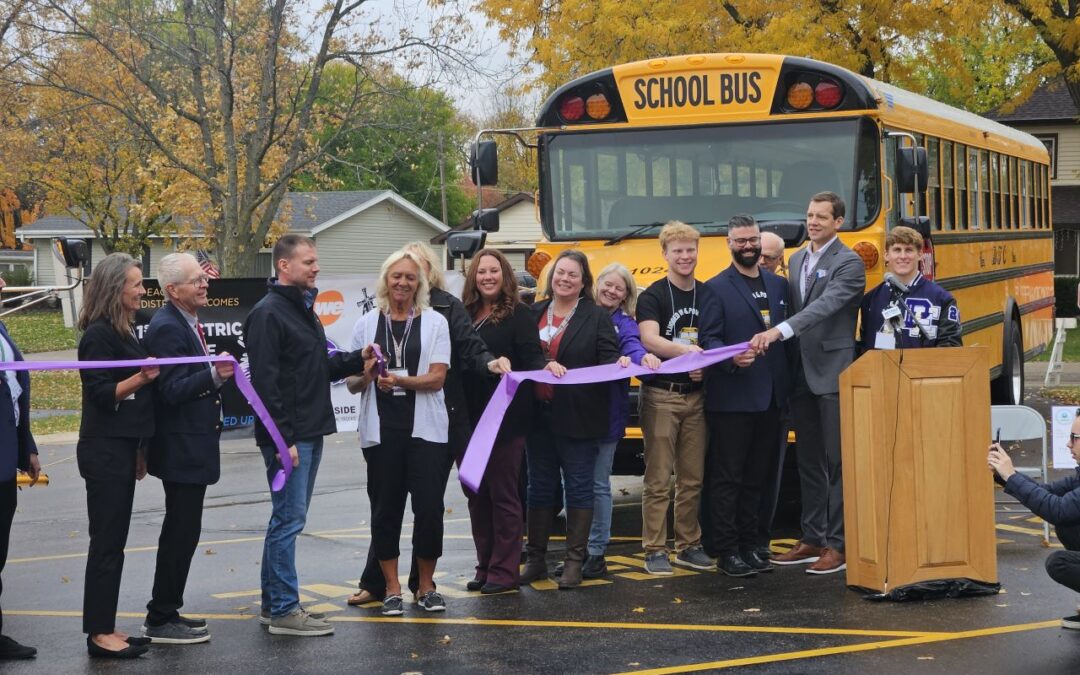
by Alex Beld | Feb 23, 2024 | Electric School Bus, Electric Vehicles, Electrification, RENEW Wisconsin
“About six years ago, this school district was on the verge of dissolving for a variety of reasons,” said Dr. Ryan Krohn, district administrator. “When we doubled down our efforts as a board to stay open, we said we’d invest in innovation and sustainable efforts.”
In the fall of 2022, the district applied for the Clean Bus Program Grant through the EPA, funded by the Bipartisan Infrastructure Law. As they charted their path forward, the leaders of the Palmyra-Eagle Area School District had to shift their thinking about the future, which ultimately led to electric buses.
When the school district learned about the EPA grant, they brought the idea of transitioning to electric buses to the school board. Together, district leaders and the board looked at how this change aligned with their goals of safe, healthy, and effective schools.
“We knew it was going to require new thinking, new experiences, and ultimately, we looked at this as a starting spot to transform our system,” Krohn said.
When considering the transition to electric school buses, the district looked at efficiencies that would be gained, not only in terms of the costs from fuel savings but also in terms of health, safety, and the environment. Addressing these aspects required the district to strengthen and build new partnerships with key stakeholders. This included energy utilities, local police, the transportation company they work with, and many other partners. Thanks to the support they received in return, they became the first school district in Wisconsin to start using electric buses to transport their students.
“There’s no way our school district, being led by someone like myself, was going to be able to be able to pull this off (alone),” Krohn said .”My background is not in this.”
The district was ultimately awarded $2 million dollars, enough for six electric school buses. Since receiving the buses, Ryan has been participating in webinars and other events to share the story of Palymra-Eagle’s journey. That journey and the connections they made along the way have led to the district leaders altering how they look at their 10-year capital plan. It has also led to greater engagement with the community.
“Our recent efforts, just because of this, ended up in our community donating money for a new greenhouse,” Krohn said. “We have a strong agricultural program in our school district.”
Both the electric school buses and this new greenhouse serve as educational tools for the students of the Palymra-Eagle School district. As Dr. Krohn said, it also empowers their students and engages them in thinking about the shifts that need to happen for our energy future.
by Alex Beld | Feb 14, 2024 | Community, Events, RENEW Wisconsin, Renewables
RENEW Wisconsin selected 13 projects for this year’s Honor Roll. These projects and the organizations involved in them demonstrate leadership, ambition, and climate awareness in their design and use of clean energy.
ALLIANT ENERGY (WPL) SOLAR PORTFOLIO
In 2023, Alliant Energy’s Wisconsin utility placed in service eight utility-scale solar plants totaling 639 megawatts as part of its Clean Energy Blueprint. By the end of the year, Alliant had finished work on 11 of the 12 projects in its solar portfolio. When the final solar plant is completed this summer, they will together generate approximately 20% of Alliant’s resource mix in Wisconsin, sufficient to power nearly 300,000 homes annually. Many Wisconsin contractors participated in the construction of these projects, including Westphal Electric and Mashuda Contractors.
BADGER HOLLOW
Developed by Invenergy and owned by WEC Energy Group and Madison Gas and Electric, Badger Hollow Solar Park is now fully operational. At 300 MW, it is Wisconsin’s largest operating solar power plant, capable of generating 6,000,000 megawatt-hours per year. This is equal to the annual consumption of 90,000 Wisconsin households. Badger Hollow was one of the first utility-scale solar plants approved by the Public Service Commission in 2019. Since then, Invenergy has secured permits for four more solar and storage projects in Wisconsin, totaling 1.35 gigawatts. Two of them are under construction today.
BAYFIELD COUNTY
Bayfield County successfully commissioned the area’s first multi-building, intelligent microgrid on November 10, 2023. The Bayfield County Courthouse and Jail automatically integrate solar PV, battery storage, and backup diesel generation under a single utility meter. The system will provide electric power with or without the electric grid and can optimize economic benefits during normal grid-tied operation through features like demand management and energy arbitrage. The system is not only a first for the area but a first for Wisconsin and the Midwest.
CITY OF MADISON
In the previous decade, the City of Madison set a goal of installing one megawatt of solar capacity by 2020 to supply its own facilities. By the end of 2022, about 1.5 MW of behind-the-meter solar power had been installed, mostly through the City’s Green Power training program. In 2023, the City added 585 kW of solar PV at nine different facilities, including 200 kW apiece at both Streets West and the Nakoosa Rd. Fleet Garage, bringing overall installed PV capacity serving City facilities to more than 2 MW.
COLLEGE OF MENOMINEE NATION
In 2023, Eland Electric partnered with the College of Menomonee Nation to install a 40-kilowatt solar array on the tribe’s reservation in Keshena. In addition to powering a college building, this array kicks off an initiative to help local community members develop the skill set needed for installing and maintaining solar arrays. The Menomonee Nation hopes to build its own reservation-wide solar energy utility service.
HOLY WISDOM MONASTERY
In 2023, Holy Wisdom embarked on an ambitious effort to become an all-electric facility using carbon-free sources onsite to the greatest extent possible. The monastery’s journey to a carbon-free future began with a significant expansion to the onsite PV capacity already in place. Designed by the team of Hoffman Planning and Madison Solar Consulting and installed by Northwind Solar, the new array is built upon single-axis trackers, and its output flows directly into the utility distribution system. When the ground-source heat pump and battery storage system are commissioned later this year, Holy Wisdom Monastery will have effectively achieved carbon neutrality. Wisconsin’s Office of Energy Innovation helped kick off this project with a $575,000 grant awarded in 2021. Local solar developer John Young contributed financing for the solar array.
MCFARLAND PUBLIC SAFETY BUILDING
In 2023, the village of McFarland celebrated the opening of its new Public Safety Center, likely the first net-zero municipal building in the state of Wisconsin. With 51 geothermal wells for efficient heating and cooling as well as solar panels that can produce up to 470kW of photovoltaic energy, the facility will produce as much energy onsite as it consumes annually, leading to its designation as a net zero facility. Taking advantage of federal and state clean energy funding (including an Energy Innovation Grant), this $20 million building should pay for itself in year one.
RED BARN WIND ENERGY CENTER
Commissioned in 2023, the 92 MW Red Barn Wind Park was developed by Minnesota-based PRC Wind and built by Allete Clean Energy for the project’s current owners, WEC Energy Group and Madison Gas and Electric. Approved by Grant County in 2019, Red Barn is the first project in Wisconsin to have advanced from the proposal stage to full operation under the state’s Wind Siting Rule (PSC 128). The output from this 28-turbine project should equal the annual consumption of 50,000 Wisconsin households.
SHEBOYGAN SENIOR COMMUNITY
Sheboygan Senior Community is a faith-based, nonprofit continuum of care facility providing respite, short-term rehab, assisted living, skilled nursing, and end-of-life services. Designed and installed by Plymouth-based Arch Solar, the installation consists of a 198-kW ground-mount solar array and a battery energy storage component. In addition to a grant from the Wisconsin Office of Energy Innovation, the project’s financing relied on a generous commercial benefactor, who provided 95% of the funding for the senior community’s project. The organization worked with Legacy Solar Cooperative to secure this funding. In addition, Couillard Solar Foundation donated one-third of the 438 panels that make up the array.
SOLARSHARE WISCONSIN
In 2023, SolarShare Wisconsin, a cooperative entity organized under Chapter 185, invested capital provided by members to bring two smaller solar projects in western Wisconsin to fruition. SolarShare Wisconsin partnered with OneEnergy Renewables, which has developed more than 20 smaller-scale solar projects across Wisconsin, to build its first two arrays in Juneau County, totaling 4.5 MW. Now energized, the Lemonweir (lemon•weer) and Webster Creek projects supply electricity to Oakdale Electric Cooperative. SolarShare Wisconsin plans to add another solar project to its portfolio later this year. At a site near Lake Hallie (rhymes with rally) in Chippewa County. Like the first two projects, the Lake Hallie project, also developed by OneEnergy, will be financed with capital provided by SolarShare Wisconsin members.
UW-HEALTH EASTPARK MEDICAL CENTER GARAGE
In 2023, UW-Health partnered with SunPeak and Staff Electric to design and oversee the construction of a 1 MW solar parking canopy on the garage adjacent to its Eastpark Medical Center. This PV canopy not only supports UW-Health’s carbon reduction goals but also provides additional protection to patients and visitors using the facility.
UW-PARKSIDE
UW-Parkside partnered with McKinstry to host a 2.1 MW solar array, similar to the one McKinstry designed for UW-Platteville a year earlier. Built on a parking lot, UW-Parkside’s array is the largest installation in 2023 serving a Wisconsin school or municipality. McKinstry selected Westphal Electric to build the structure and interconnect the PV system to the grid. The electricity generated by the McKinstry/Westphal installation flows directly to UW-Parkside campus buildings.
YAHARA SOLAR
As noted on Dane County’s website, the 17-megawatt Yahara Solar project, completed in 2023, enables Dane County to become not only the first county government in the state to achieve 100% renewable electricity status, but also the 4th county in the nation to reach the 100% goal. Key partners in the project include Alliant Energy (the local utility), SunVest (the project developer and owner), and Pieper Power (the installation contractor). Yahara Solar will produce more than 36 million kilowatt-hours of renewable electricity per year — enough to power more than 3,000 Dane County homes.
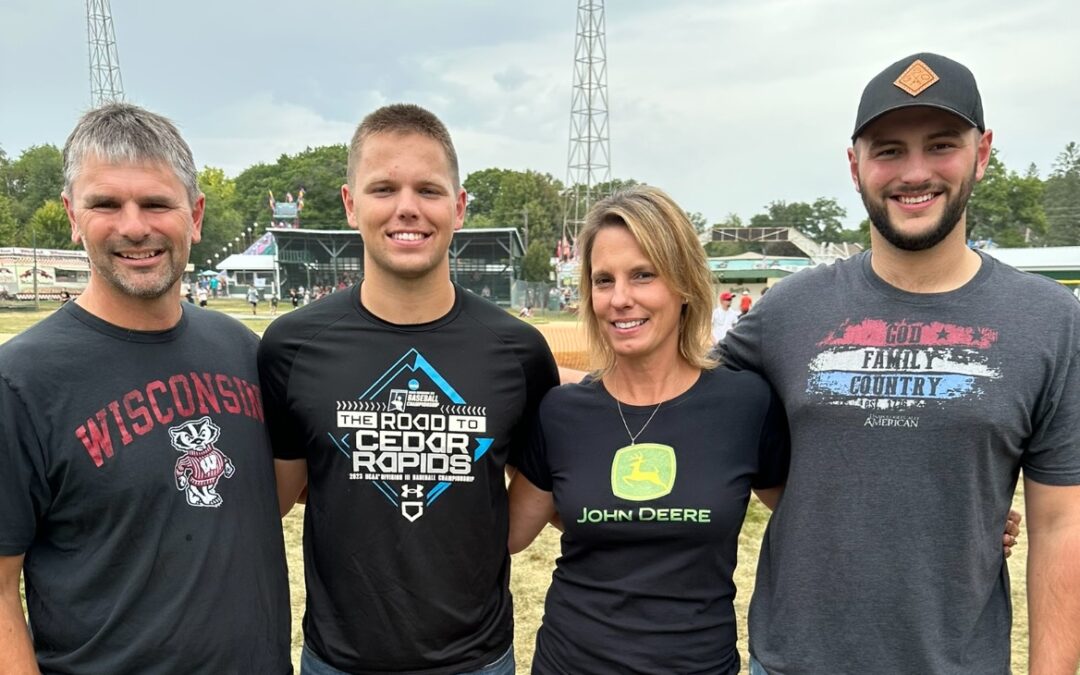
by Aisha Anderson | Feb 9, 2024 | Inflation Reduction Act, REAP, Solar, Sustainable Business, Sustainable Businesses
Photo Credit: Brett Carlson – Owner and Founder of Ag & Business Solar Partners
In 2020, Brett Carlson and his dad, Carl, decided to install solar panels on the farm using the financial support offered through the Rural Energy for America Program (REAP). The complexities of this process inspired the creation of his company, Solar and Ag Business, whose goal is to help farmers and small businesses reap the benefits of solar energy.
The Rural Energy for America Program (REAP) is a federal program that provides financial assistance to agricultural producers and rural small businesses to make the switch to renewable energy. The REAP Grant was established in 2002, and up until 2023, the grant covered 25% of the total project costs. The grant was expanded to cover 40% of the total project cost in early 2023 and then increased to 50% of total project costs thanks to additional funding from the Inflation Reduction Act (IRA). When you factor in tax credits and depreciation, Wisconsin farmers and small businesses can install solar at a fraction of the cost.
Solar energy can reduce energy bills, benefitting the bottom lines for farms and rural small businesses that are often looking for additional efficiencies to help keep their businesses viable.
“Of the many volatile expenses that come with farming, this is one that we can control. The initial overhead cost of installing solar was a barrier that most farmers weren’t able to overcome until now,” Brett said.
The benefits of the REAP Grant to rural America are significant, but the lack of education about solar in rural areas and the complexities of the REAP grant application itself presents a challenge. Brett experienced this firsthand when he helped his parents apply for the REAP grant. Brett explained that he and his parents left that experience feeling frustrated as they were pushed to outsource help for the REAP application to “predatory consultants and grant writers,” who knew that most farmers could not navigate grant jargon on their own.
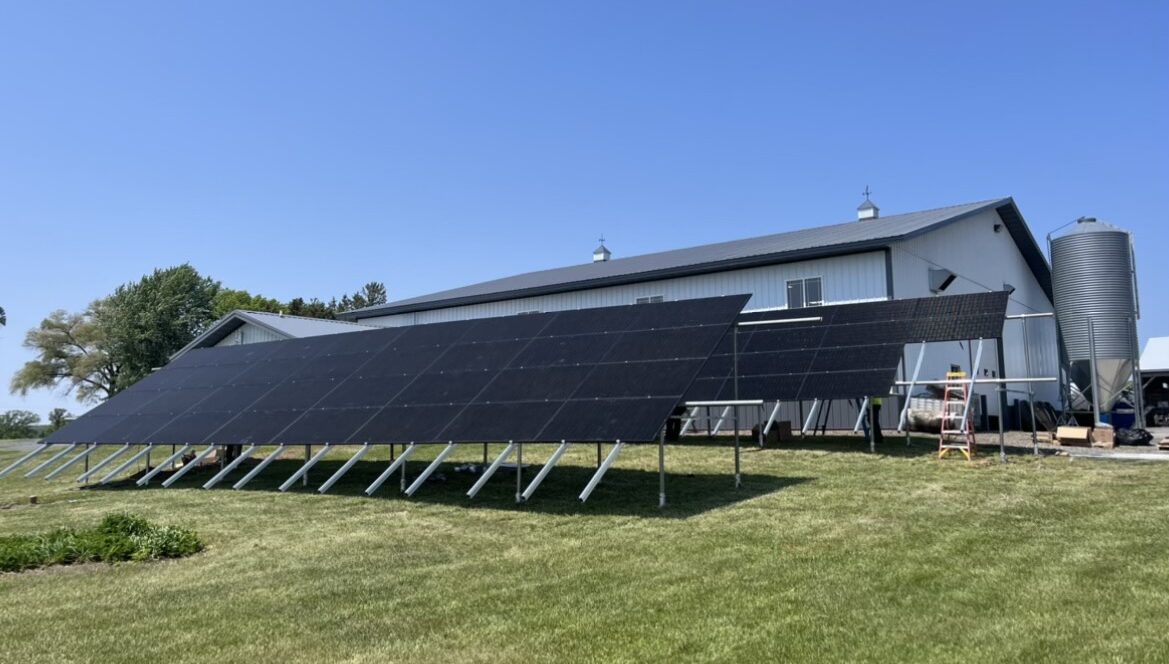
AG and Solar Partners grew from that frustration, and now Brett helps navigate federal incentives and tax benefits and connect farmers and small business owners to trustworthy clean energy businesses. One of Brett’s clients, Dan Tronrud, is an auto shop owner in Wolf River. Dan praises Brett’s passion for making solar energy accessible to his community.
When asked about his experience with applying for the REAP Grant, Dan exclaimed, “He’s excited, and he gets me excited. He knows everything about solar and electricity and is so good at breaking it down. There are no questions left unanswered.”
With the help of Ag and Business Solar, Dan was able to submit his application for the December 2023 grant cycle and hopes to bring solar panels to his shop.
Brett’s background of growing up on his family farm and then going on to study business and entrepreneurship offers him a unique skill set that empowers him to navigate complex conversations with business partners, consultants, and farmers around the intricacies of implementing solar energy on a commercial scale while taking advantage of federal incentive tax benefits.
“As a business owner, the transition to solar makes total sense,” Brett said. “Politics aside, look at the numbers, they work. The math makes sense. It’s a no-brainer with the REAP grant and tax incentives.”
The benefits of transitioning to solar energy as a business decision are clear, immediate, and accessible with the help of the REAP Grant and IRA incentives.
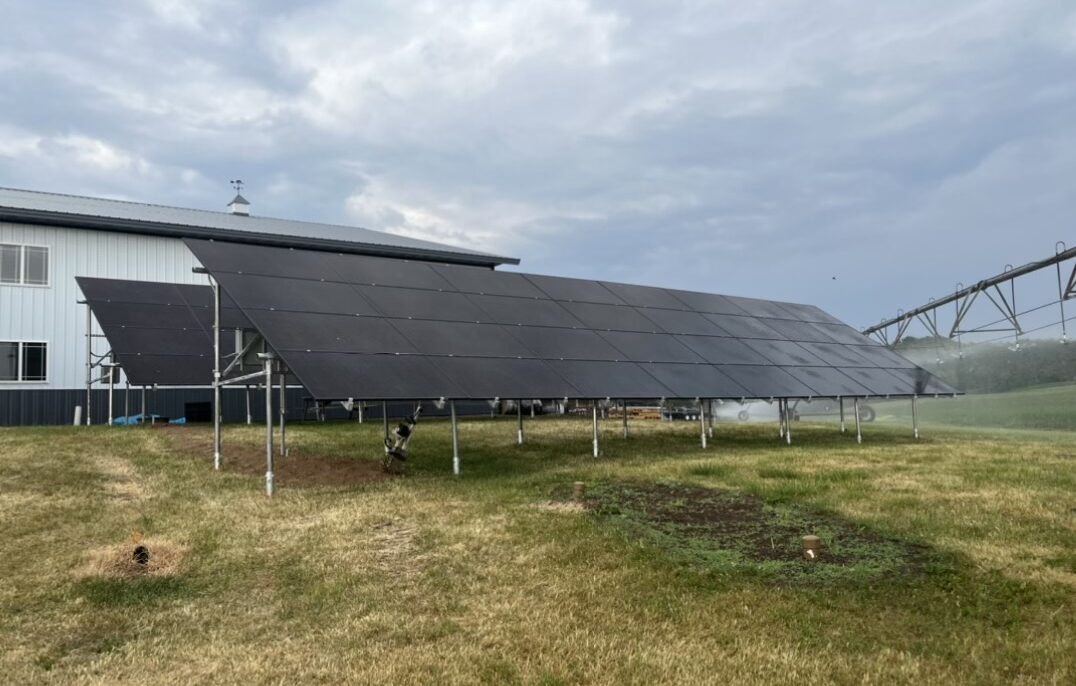
“Each generation did something innovative—something that no one else was doing,” Brett said. “My dad was way ahead of his time, he put up wind turbines, the first one in our town.”
He and his parents see solar as a partial solution to the deteriorating electricity grids in rural areas.
“It’s aging, expensive to maintain, and it’s not fair that there are no other options provided by utility companies,” Brett said. “Transitioning to solar is a way for us to have agency to protect ourselves from outdated grids. I want people to recognize how this technology benefits us. I grew up in this community, and I will spend the rest of my life here. I don’t want to keep watching my loved ones and the people that I grew up with struggle to stay in business if there is something that can be done to help. That’s why I’m doing this. I want this community to not only stick around but to thrive.”
Because of the success of past clean energy projects with the REAP grant, it will be continuously funded through the IRA with $2 billion spread throughout a ten-year span. Farmers and small business owners interested in applying for the REAP grant should send their application materials to their local Rural Development State Energy Coordinator or contact Brett. Deadlines for the 2024 grant cycles are March 31, June 30, and September 30. Funding guidelines are state and project-specific, which is where Brett’s expertise at AG and Business Partners can be useful. Brett offers free consultations for small businesses, residential properties, and farms throughout rural Wisconsin.

by RENEW Wisconsin | Feb 5, 2024 | Community, Events, RENEW Wisconsin
On Thursday, February 1, RENEW held our 13th annual Renewable Energy Summit, presented by Arch Solar and Invenergy. More than 700 Attendees from across Wisconsin, the Midwest, and even around the globe joined us as we discussed how to unleash the power of Wisconsin’s clean energy potential.
Our amazing cast of panelists, presenters, and guest speakers covered:
- Emerging Technologies: Delve into the latest breakthroughs in clean energy technologies, from advanced renewables to energy storage and grid innovations.
- Economic Transformation: Explore how the clean energy sector is reshaping Wisconsin’s economy, generating jobs, and fostering economic growth.
- Community Power: Hear how community-led clean energy initiatives empower local residents to actively participate in the energy transition.
- Energy Policy and Legislation: Gain insights into Wisconsin’s evolving energy policies and regulations and hear from policymakers and legal experts about the opportunities and challenges facing the clean energy sector.
- Rural and Urban Integration: Showcase successful strategies for bridging the urban-rural divide in clean energy adoption and development.
- Inclusive Sustainability: Focus on equity, diversity, and inclusion in the clean energy sector to ensure that everyone benefits from its growth.
- Clean Energy Workforce Development: Focus on building a skilled workforce to meet the demands of a growing clean energy sector and create high-quality jobs.
- Educational Catalyst: Examine the role of education and research institutions in driving clean energy innovation and workforce development.
- Resilient Infrastructure: Address the importance of building resilient energy systems capable of withstanding disruptions and extreme weather events.
- Investment and Financing: Explore investment opportunities and financing models that support the scaling of clean energy projects.
- Collaborative Partnerships: Encourage collaboration between government, industry, academia, and local communities to foster a thriving clean energy ecosystem.
We were also joined by the likes of Tonya Hicks, Robert Blake, and State Representative Supreme Moore Omokunde. Tonya Hicks shared with attendees not only how we can go about building a diverse workforce, but why it is necessary for the success of the industry. Robert Blake talked about the potential of existing renewable energy technologies and how the industry can go about finding the workers needed to achieve that potential. And Supreme Moore Omokunde closed out the Summit with a reminder that our transition to clean energy should be equitable, and that we must ensure access to renewables for low-income and minority communities.
Attendees also learned that this would be the last RENEW Wisconsin Summit with Michael Vickerman joining us as a RENEW staff member. Though Michael does plan to retire this spring, he has promised that this won’t be the last we hear from him. Michael’s role at RENEW and in Wisconsin’s renewable energy industry cannot be understated and we’re excited to see what he gets up to in his retirement.
We are proud to say that our Summit continues to grow in size and scope. The energy and engagement at this year’s summit were inspiring, and it’s all thanks to the sponsors, volunteers, speakers, attendees, and everyone else who joins us each year to make it happen!

by Alex Beld | Jan 23, 2024 | Press Release, RENEW Wisconsin
January 22, 2024, Madison, Wis. — During its 13th annual Renewable Energy Summit, RENEW Wisconsin, with presenting sponsors Arch Solar and Invenergy, will honor those who made significant and lasting impacts on Wisconsin’s clean energy industry. The Summit will take place Thursday, February 1, 2024, at Monona Terrace in Madison.
RENEW’s 2024 Summit, titled “Unleashing the Power of Wisconsin’s Clean Energy Potential,” gathers industry experts, policymakers, innovators, and community leaders dedicated to accelerating the transition to clean energy sources. Featured speakers include Tonya Hicks, CEO of Power Solutions, Inc., and Robert Blake, Owner of Solar Bear and Executive Director of Native Sun Community Power Development.
The awards are grouped under three categories:
- Clean Energy Champion: Maria Drews, Co-owner – Drews Solar
- RENEW Member of the Year: Full Spectrum Solar – Madison WI
- Energy Reporting Excellence: Jana Rose Schleis, Enterprise and Investigative Reporter – The Cap Times
The ceremony will conclude with the 2023 Clean Energy Honor Roll, in which RENEW will recognize 13 clean energy projects in Wisconsin that recently commenced operation. Whether on the basis of their productivity, innovativeness, attention to detail, scale, resourcefulness, or efficacy in reducing carbon emissions, these projects showcase the skills and know-how Wisconsin stakeholders bring to the clean energy marketplace.
Clean Energy Honor Roll:
Alliant Energy Solar Portfolio, Dodge, Grant, Green, Jefferson, Rock, Sheboygan, and Waushara Counties
Eight solar PV power plants – 639 megawatts.
- Badger Hollow, Iowa County
The largest solar PV power plant in Wisconsin – 300 megawatts.
- Bayfield County, Bayfield County
Microgrid project that integrates solar PV, battery storage, and an existing backup diesel generator.
- City of Madison, Dane County
Nine (9) behind-the-meter solar PV installations – 585 kilowatts.
- College of Menominee Nation, Menominee County
Ground-mount solar PV array – 40 kilowatts.
- Holy Wisdom Monastery, Dane County
Net-zero project featuring onsite solar, with battery storage, and ground-source heat pumps.
- McFarland Public Safety Building, Dane County
Net-zero building featuring onsite solar and ground-source heat pumps.
- Red Barn Wind Energy Center, Grant County
Wind power plant – 91.6 megawatts.
- Sheboygan Senior Community, Sheboygan County
Ground-mounted solar array & battery – 198 kilowatts.
- SolarShare Wisconsin, Juneau County
Two cooperatively-owned solar arrays – 4.5 megawatts.
- UW-Health Eastpark Medical Center Garage, Dane County
Solar PV parking canopy – 1,032 kilowatts.
- UW-Parkside, Kenosha County
Ground-mounted solar PV array – 2.1 megawatts.
- Yahara Solar, Dane County
Largest solar array built for one customer – 17 megawatts.
The 13th Renewable Energy Summit will also feature an exposition hall with nearly 50 exhibitors, breakout sessions, and industry professionals discussing current and future opportunities for advancing clean energy in Wisconsin. Nearly 100 organizations have also voiced their support of renewable energy by sponsoring the summit. For more information on the 2024 Summit program agenda, speakers, sponsors, registration, or press passes, please email Alex Beld (abeld@renewwisconsin.org).

by Beata Wierzba | Jan 23, 2024 | Advocacy, Electric Vehicles, Local Government, Public Service Commission
Wisconsin’s state legislature has acted swiftly this January to move legislation impacting electric vehicles (EV) through the legislative process. The Senate version of the proposed EV bill, SB 791, has already passed through the Senate Utilities & Technology Committee with a recommendation for passage. Similarly, the Assembly version of the bill, AB 846, cleared the State Assembly Committee on Energy & Utilities.
The legislation also passed through the Joint Committee on Finance and Joint Survey Committee on Tax Exemptions, gathering favorable votes. Most recently, the full Senate passed their version of the bill in a 30-2 vote. The next step is a vote by the full Assembly after which the bill will go to the Governor’s desk.
As with all legislative bills, amendments and tweaks along the way are common. There have been three amendments added so far, and we are analyzing the impact of these on the original bill.
The focus of the bill is to allow non-utilities to seek payment from EV drivers based on the amount of electricity they use to charge their vehicles rather than the time it takes for the vehicle to charge. This qualifies Wisconsin public and private entities to receive federal dollars to help build charging infrastructure while also establishing operational and maintenance requirements for the chargers.
National Electric Vehicle Infrastructure (NEVI) funding would be available for up to 5 years, which is especially beneficial for areas where the market is not yet ready to support EV infrastructure but could in a few years. This allows the areas that currently have less EV traffic to build EV charging infrastructure to support a growing user base.
RENEW initially raised concerns about the impact the bills would have on existing EV charging facilities and the need for the state to have similar opportunities for infrastructure that local governments would. Those concerns have been addressed in part within the proposed amendments.
SB 791 and AB 846 bring Wisconsin in line with 48 other states while providing uniform access, pricing, accountability, and standards for EV Charging. We expect to see the bill become law.
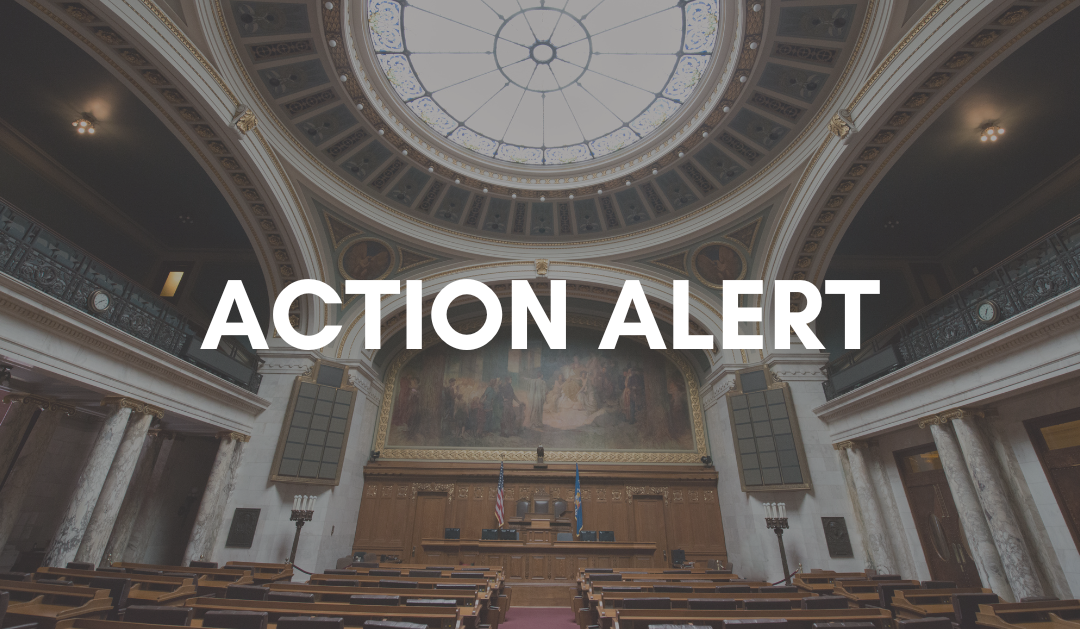
by RENEW Wisconsin | Jan 12, 2024 | Action Alert
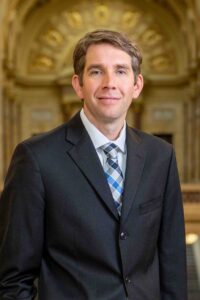 The Wisconsin State Senate will vote on Public Service Commission of Wisconsin (PSCW) Commissioner Tyler Huebner’s appointment this week. Help us keep Wisconsin moving forward by urging your State Senator to vote to confirm Commissioner Huebner.
The Wisconsin State Senate will vote on Public Service Commission of Wisconsin (PSCW) Commissioner Tyler Huebner’s appointment this week. Help us keep Wisconsin moving forward by urging your State Senator to vote to confirm Commissioner Huebner.
With the recently announced resignation of Chairperson Rebecca Valcq, a “no” from the Senate on Commissioner Huebner’s would create uncertainty at the PSCW, and stall progress.
There is broad support for his appointment — including from four of the five investor-owned utilities that service Wisconsin. Since his appointment nearly four years ago, Commissioner Huebner has:
- Approved hundreds of megawatts of homegrown clean energy.
- Voted in favor of net metering, protecting Wisconsin’s solar industry.
- Served as Board President of the Organization of MISO States, ensuring Wisconsin constituents like me benefit from improved energy infrastructure.
- Offered expert insight and knowledge of renewable energy and energy efficiency, helping the Commission make smart energy decisions for Wisconsin.
The Wisconsin Senate Committee on Utilities and Technology has already voted 3-2 against Commissioner Huebner. Your voice is required to ensure the full Senate doesn’t do the same.
by Lynn Markham | Jan 8, 2024 | Electric Vehicles, Electrification
The number of electric vehicles (EVs) is increasing rapidly in the U.S. and worldwide. Wisconsin saw an increase from 319 EV registrations in 2013 to 9,039 EV registrations in 2021 and 13,893 EV registrations in 2022. The increase is driven by several factors, including advances in technology, cost savings for EV owners, decisions made by state policymakers, and commitments by automakers. By the year 2030, there may be as many as 19 million EVs on the road in the U.S.
Adopting EV charging standards can save businesses and homeowners money because it’s much less expensive to install EV charging infrastructure during new construction than it is to retrofit buildings after they are built. Municipalities need to plan for the increasing number of EVs and the cost savings of installing EV charging infrastructure during new construction so that residents can access charging stations at businesses and their homes.
What Policies Help Ensure EV Readiness?
In Wisconsin, the two main tools that take advantage of building and parking infrastructure to move us toward EV readiness are zoning and building codes. The following offers a short explanation of each policy tool, its current status in Wisconsin, and examples.
Zoning
More than fifty state and local governments in the U.S. have enacted zoning ordinance amendments or building code amendments to ensure EV readiness. Each local government decides individually which provisions to include in their general zoning ordinances. Zoning ordinance amendments for EV chargers typically have three components:
- EV charging definitions
- Designated zoning districts for EV charging stations
- Requirements for electrical wiring and other infrastructure for EV chargers in new construction (optional)
When deciding where EV charges will be permitted, it is important to keep in mind that, unlike gas stations, EV charging stations don’t create the risk of fuel spills, underground fuel leaks, or fumes. Example approaches include:
- Allowing Charging stations in all zoning districts as was done in Des Moines, IA
- Allowing level 1 and 2 charging stations in all districts and allowing level 3 fast chargers in industrial and highway commercial districts as was done in Chelan, WA
You can choose from the menu of zoning provisions for EV chargers in Ready for Electric Vehicles? Modifying Local Land Use Policies starting on page 8 to tailor ordinance provisions to fit your community.
State and Local Building Codes
Wisconsin has a state-level Uniform Dwelling Code (UDC) and a Commercial Code that are adopted by the Wisconsin Department of Safety and Public Services. This does not include standards for wiring or other EV charging infrastructure. Municipalities cannot alter these building codes, so they are precluded from including EV charging station requirements. This is true for the state’s Uniform Dwelling Code for one and two-family dwellings and the state’s commercial building code.
Many states and municipalities use the International Building Code as their base code and may add additional standards to tailor the code to their community.
- International Building Code. The International Building Code (IBC) is updated every three years, and the 2021 code went into effect in October 2021. The IBC is a set of voluntary guidelines used by many states. The 2021 IBC calls for one EV-ready parking space, which means installing panels, outlets, and conduits capable of charging at least one full-size EV in a single-family garage overnight. Multi-family buildings will need two EV-ready parking spaces, along with more that can be easily retrofitted, a standard known as EV-capable. The decision to install an EV charger is left to the property owner.
- State and local building codes:
- In the central part of the U.S., Minnesota, Kansas, and North Dakota have adopted the 2018 IBC in their state building codes.
- In contrast, Wisconsin has its own residential code, known as the Uniform Dwelling Code (UDC) for one and two-family dwellings based on the 2009 IBC, and a commercial building code based on the 2015 IBC.
- On August 10, 2023, the Wisconsin Senate Housing, Rural Issues, and Forestry Committee rejected an update to bring the state’s commercial building codes up to date with the 2021 IBC.
- A Wisconsin law passed in 2013 established a uniform statewide commercial building code and prohibits municipalities from adopting or enforcing their own standards, making Wisconsin one of only three states to restrict local control, according to the American Council for an Energy-Efficient Economy. Similarly, the Wisconsin UDC does not allow municipalities to adopt more stringent standards. The current Wisconsin building codes do not include standards for EV charging standards, and communities cannot add these standards to their building code. Wisconsin is working on updating its building codes, which are outdated. Big EV infrastructure questions in these updates are as follows:
- Will Wisconsin adopt a UDC and commercial code that includes current EV infrastructure standards?
- Will Wisconsin change from one-size-fits-all UDC and commercial code to allow communities to choose to tailor their building codes, which could include requiring EV-ready parking spaces?
Takeaways
Driving electric has many benefits. The number of EVs and EV charging stations are increasing rapidly. While current EV drivers in the U.S. charge 80% of the time at home, one-third of Wisconsin households rent their home and do not get to decide if EV charging is available where they park. The installation of EV charging infrastructure is four to six times less expensive when included during new construction versus a building retrofit. Because of this, EV charging standards in building codes and zoning ordinances can save businesses and homeowners money.
Each local government decides individually which provisions to include in their general zoning ordinances. Zoning ordinances are useful tools for local governments to indicate where public EV charging is allowed or prohibited. Local governments may also choose to require electrical wiring and other infrastructure for EV chargers in new construction.
EV charging standards are not included in the current statewide Wisconsin UDC or commercial building code. Current Wisconsin laws do not allow communities to voluntarily add EV charging standards to their building codes. When tailoring EV charging standards to fit communities, we can learn from the many states and communities that have already amended their zoning ordinances and building codes to ensure EV readiness.
– Lynn Markham, Center for Land Use Education

by Beata Wierzba | Dec 21, 2023 | Advocacy, Community Solar, Electric Vehicles, Legislative Watchlist, Local Government, Policy, Solar
Though the year is coming to a close, RENEW Wisconsin’s efforts to support electric vehicle (EV) charging and community solar will continue into 2024. RENEW staff recently had the opportunity to testify before the Senate Committee on Utilities and Technology to share our support for SB 791.
We are also working with the Community Solar Coalition to get a hearing on the community solar bill. The Coalition is reaching out to leadership in the state legislature along with the chairman of the Senate Committee on Utilities and Technology to advance the bill to the next step.
EV Charging – SB 791
RENEW Wisconsin staff testified before the Senate Committee on Utilities and Technology on December 19, 2023. In our testimony we shared our support for SB 791, explaining that it will align the state of Wisconsin’s laws with the National Electric Vehicle Infrastructure (NEVI) Standards and Requirements set by the Federal Highway Administration and qualify for NEVI funds.
NEVI requires that the payment for charging your vehicle be based on kilowatt hours of electricity used rather than time. In Wisconsin, making electricity available by the kilowatt hour (kWh) is restricted for non-utilities. As it stands, the EV stations operating in the state have consumers pay by the amount of time it takes to charge rather than the amount of electricity used.
Allowing private entities to sell electricity by the kWh to charge an electric vehicle without being regulated as a utility will grant Wisconsin $78 million in NEVI dollars. These dollars are needed to fund the build-out of electric vehicle charging infrastructure and establish operational and maintenance standards.
This bill will bring Wisconsin in line with 48 other states and provide uniform access, pricing, accountability, and standards for EV Charging. More importantly, establishing the kWh standard for Wisconsin is time-sensitive as the deadline to qualify for the NEVI funds is the end of February 2024.
During our testimony, we recommend two improvements:
First, we ask for the grandfathering of all existing EV charging facilities up to the date when this new law becomes effective. We believe that early adopters of EV charging should not be forced to make costly changes to their existing systems and investments. Additionally, allowing the current economic and ownership arrangements to continue would not compete with the new systems but rather continue serving the market.
Second, we asked that the bill be modified to allow state government entities to lease land for charging or that they be able to partner with a private entity to host facilities. This change would allow charging stations to be placed in remote places that private businesses may not find suitable.
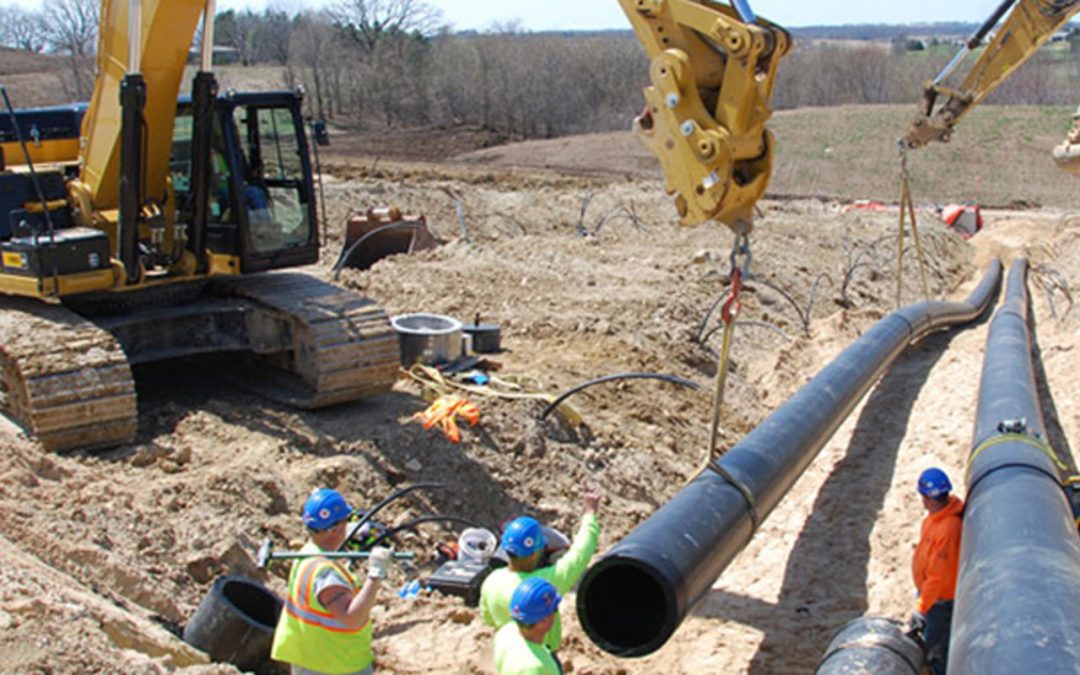
by Francisco Sayu | Dec 20, 2023 | Geothermal
Photo Credit: James Tinjum – Associate Professor & Director of the Geological Engineering Program at UW-Madison
Energy is the driving force of our world, powering everything from our cars to our phones and the way we generate our energy is closely tied to our health and economic prosperity. Current environmental and economic pressures are moving us toward cleaner and cheaper energy systems. As this transition gains speed it allows us to uplift communities that have been historically marginalized by disinvestment and pollution. However, this transition is complex and requires education so that all stakeholders understand the risks and opportunities ahead. To achieve success, we must understand the technologies and the tools required to grow the economy, increase energy independence, and improve our health and well-being. The purpose of this writing is to discuss geothermal energy and explore how this technology fits in the context of Wisconsin.
I have been fortunate to work in the clean energy industry for the past decade. During this time, I have learned that “geothermal energy” means different things to different people. While it is acceptable for the term “geothermal” to describe both renewable energy systems and energy efficiency measures, we must understand the differences between the two. Just like the word “cassette” can refer to a collection of sprockets in a bicycle or an analog audio recording device, the term “geothermal” can describe either a way to generate electricity from high-temperature water reservoirs (renewable energy) or a strategy to maximize the efficiency of an electric appliance (energy efficiency).
Renewable energy sources such as solar panels or wind turbines do not require any fuel input to generate electricity, as they convert light or the kinetic energy of air into electricity. Meanwhile, energy efficiency measures aim to increase the amount of work that can be done per unit of energy, regardless of the energy source. In the following paragraphs, I will explain the differences between geothermal renewable energy, which results in electricity generation, and geothermal energy efficiency, which is implemented with geothermal heat pumps. Additionally, I will provide examples of how geothermal energy can help Wisconsin residents and businesses save both energy and money.
Geothermal Energy – The Big “G”
Geothermal energy is a renewable source of heat that comes from the Earth’s interior. Geothermal heat is derived from naturally formed or artificially created reservoirs of hot water found at varying depths and temperatures below the Earth’s surface. Natural hot springs and the famous Old Faithful geyser in Yellowstone National Park are good examples of natural geothermal energy. In contrast, artificial geothermal (also known as enhanced or engineered geothermal energy) is captured by pumping cold water into hot rock deep under the Earth’s surface. This process transfers heat from the hot rock to the water and produces steam. Geothermal heat, both natural and enhanced, can be utilized as an energy source for district heating or converted into electricity using turbines.
In Iceland, about 90% of homes are heated using hot water or steam from natural geothermal fields located near one of the country’s 600 hot spring areas. Geothermal also provides 30% of Iceland’s electricity. Geothermal electricity is produced by spinning a turbine coupled with a generator. Once the turbine starts rotating, the generator converts the kinetic energy of the rotor into electrical energy, just like in a coal or gas plant. The main difference is that coal or gas plants require a fossil fuel input, while geothermal plants don’t need any fuel, just the heat from the Earth. In other words, all the mechanical energy required to operate the geothermal plant is derived from a geothermal reservoir located near or below the plant, which makes geothermal electricity clean, renewable, cost-effective, and available 24/7.
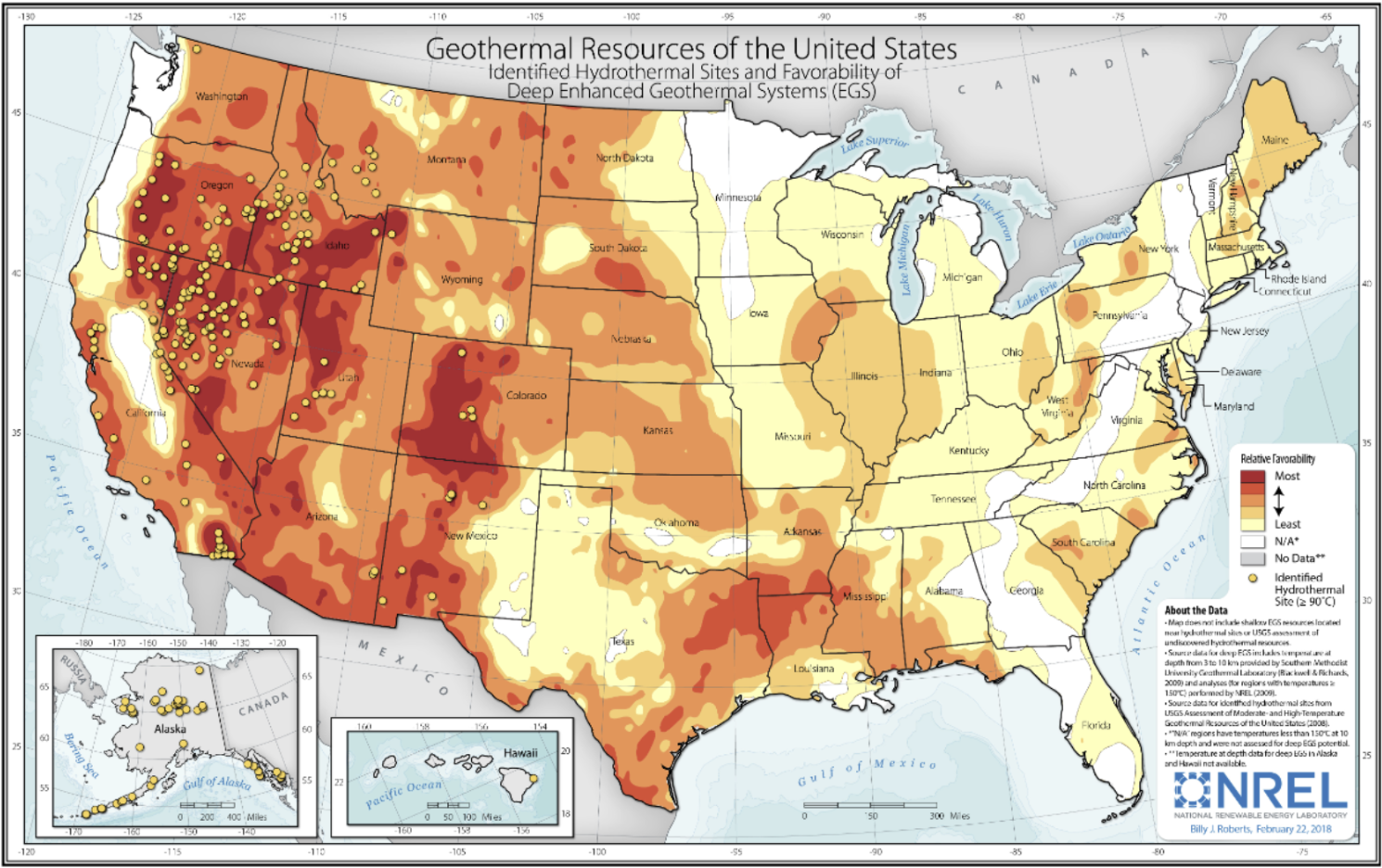
The United States is also a leader in installed geothermal capacity. According to the National Renewable Energy Laboratory (NREL), geothermal heat contributed 210 trillion BTU (about 0.2% of the total energy consumed) in the U.S. in 2022. Geothermal electricity is currently generated in several states including California, New Mexico, Utah, Nevada, Idaho, Oregon, Alaska, and Hawaii. The U.S. Department of Energy (DOE) has identified significant geothermal resources, most of which are located west of the Mississippi River, and estimates that geothermal can contribute up to 8% of the country’s energy needs by 2050. At the time of this writing, Wisconsin has no known hydrothermal resources suitable for renewable geothermal energy generation.
Geothermal Heating and Cooling
– The little “g”
Heating and cooling are essential aspects of building operation, especially in regions with wide temperature variations like Wisconsin. According to the Energy Information Administration (EIA), space heating and cooling account for over 40% of energy usage in commercial buildings and nearly half of the average home’s energy usage. Many homes and commercial buildings in Wisconsin use natural gas furnaces for heating and mechanical air conditioners for cooling. Heat pumps are quickly becoming a cost-effective alternative to the furnace and air conditioner combo, as they can provide both heating and cooling using a single appliance and rely on electricity rather than gas or other combustible fuels. Think of a heat pump as a device that moves heat from a heat source to a heat sink. A refrigerator provides a good example of how a heat pump works. The heat pump in a refrigerator uses electricity to transfer heat from inside the fridge (heat source) to the air outside the fridge (heat sink), thus reducing the temperature inside the fridge and keeping the food fresh.
Heat pumps can output several units of energy for every unit of energy input. For instance, a heat pump that delivers three (3) units of heat (measured in British Thermal Units or Btu) and consumes one (1) Btu has a Coefficient of Performance (COP) of 3. This means that the heat pump has an efficiency of 300%. To compare, the most efficient gas furnaces on the market are only 98% efficient. Therefore, the heat pump in this example is three (3) times more efficient than a furnace. Some people argue that expressing efficiency in values above 100% is wrong, which is why heat pumps are usually rated in terms of their COP instead of their efficiency.
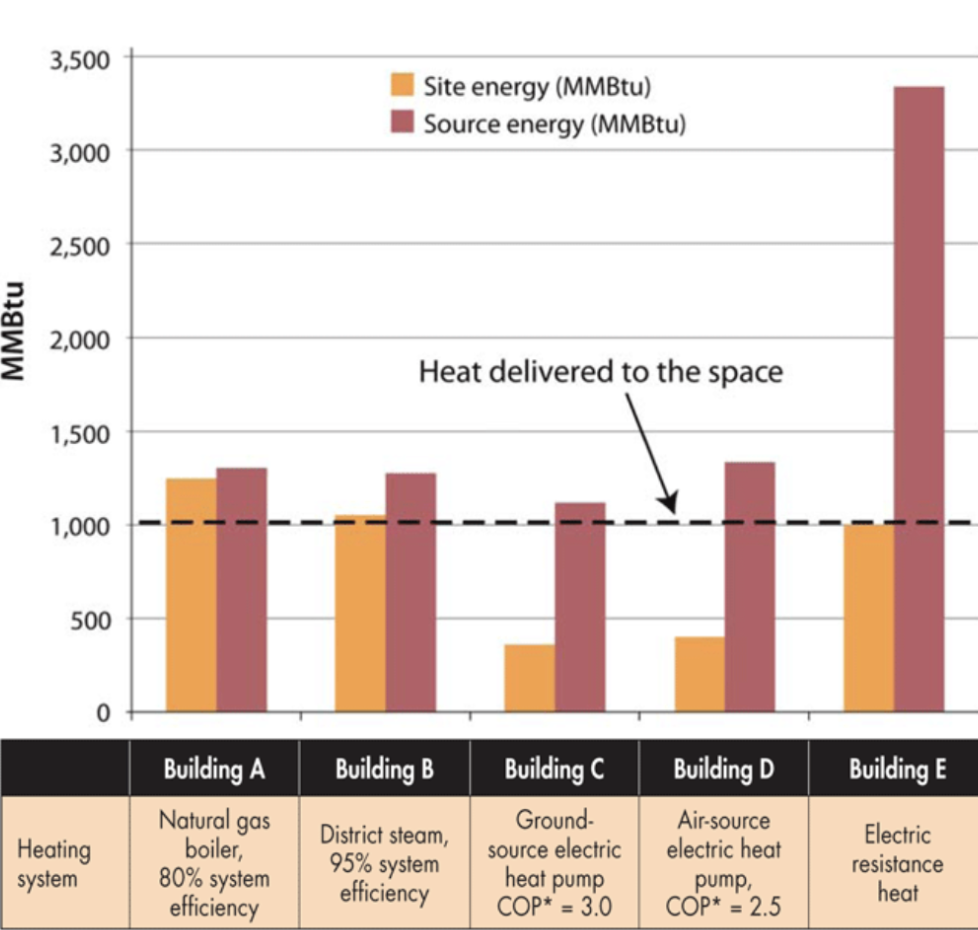
Heat pumps can move energy from air to air (air-source heat pumps) or from water to air (water-source heat pumps). Both air-source and water-source heat pumps can work in reverse. For example, a water-to-air heat pump can also move heat from air to water. It is also important to note that all heap pumps function in the same manner. Whether it is an air-source heat pump or a water-sourced heat pump, the same thermodynamic principles apply. The function of the heat pump is to move – rather than generate – heat.
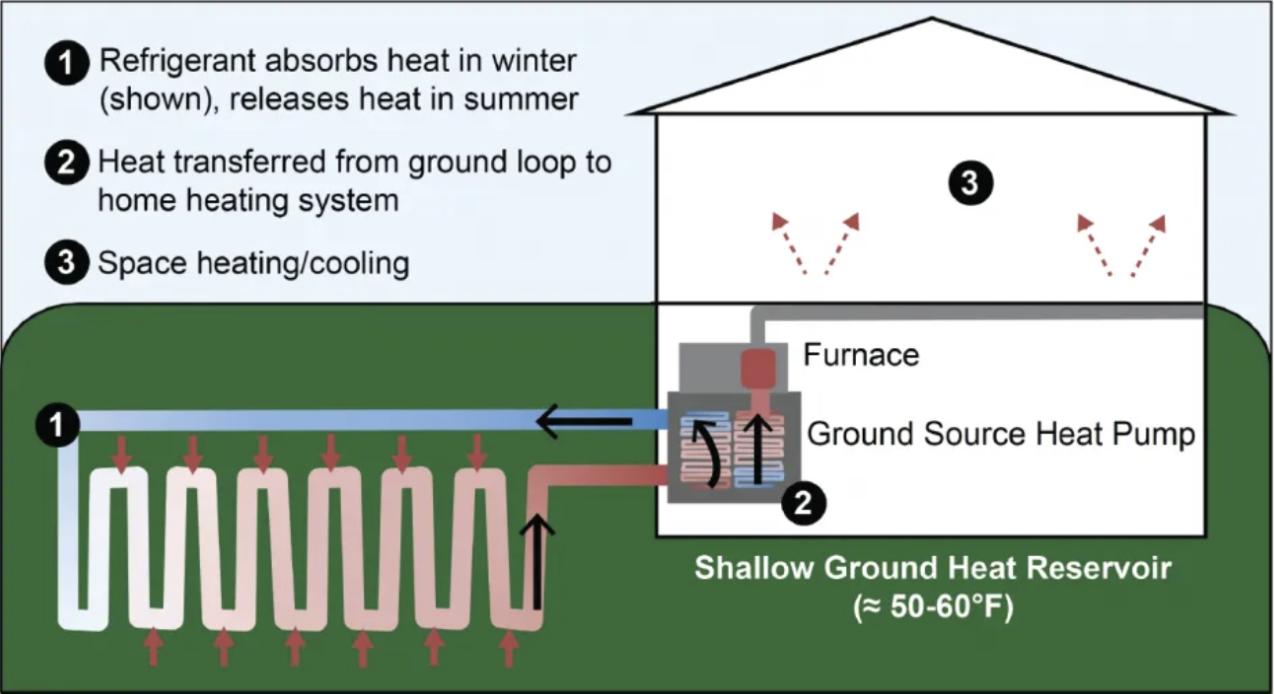
Geothermal heat pumps are heating and cooling appliances. Heat pumps move heat from the geothermal field into a building during the heating season and from the building into the geothermal field during the cooling season. The geothermal field is a heat exchanger, typically composed of a set of pipes buried underground or submerged in a body of water, which acts as a heat source in the winter and as a heat sink in the summer.
Geothermal Heat pumps have a significant advantage over air-source Heat pumps in areas with high-temperature variations, such as Wisconsin, because the ground temperature in these regions remains relatively constant year-round. For example, Wisconsin’s air temperature can drop below zero in the winter and reach over 90 °F in the summer. Yet, the temperature of the ground eight feet below the surface remains relatively stable at about 45-58 °F throughout the year. Contrary to popular belief, the ground around the geothermal field does not store solar energy. The earth’s temperature at that depth is constant throughout the year. Therefore, In the summer, the ground is generally cooler than the air, while in winter, the ground is typically warmer. Geothermal Heat pumps take advantage of this constant temperature to reduce the amount of energy required for heating and cooling, decreasing the overall energy consumption of a building.
Geothermal heat pumps are becoming increasingly popular in Wisconsin. At the Epic Campus in Verona, thousands of miles of geothermal pipes that stretch 500 feet underground are connected to heat pumps that heat and cool the buildings. The Discovery World Museum building in Milwaukee is another great example of a geothermal system that uses heat pumps and water from Lake Michigan as the heat source. Although the systems at the Epic Campus and the Discovery World Museum use different heat sources, the heat pumps in both of these facilities work in the exact same way. They use the relatively constant temperature of the earth or the lake to heat and cool buildings, which saves energy and money compared to traditional furnaces and mechanical air conditioners.
Conclusion
Geothermal electricity is a reliable, cost-effective, and renewable source of energy that has the potential to make a significant contribution to the energy supply in the United States. The geothermal resources in the U.S. are mainly concentrated west of the Mississippi River, which means that Wisconsin has limited opportunities to access geothermal reservoirs that are hot enough to generate renewable electricity. However, the varying temperatures between the ground, water, and air in the state provide an excellent opportunity to leverage geothermal heat pumps for heating and cooling purposes. Furthermore, geothermal heating and cooling systems work well in tandem with rooftop solar because the heat pump regulates the building’s temperature using electricity provided by the on-site solar panels, lowering energy costs, and transmission losses, and reducing greenhouse gas emissions.
Heat pumps are currently the most energy-efficient heating and cooling systems available in Wisconsin. The state has a growing number of geothermal facilities, including the 1,100-acre headquarters of medical software giant Epic Systems. The Inflation Reduction Act (IRA) provides substantial incentives for geothermal heat pumps and solar, and Wisconsin’s Focus on Energy® Program also incentivizes equipment that reduces energy consumption in new and existing buildings. Taking advantage of these incentives can help reduce the state’s reliance on imported fossil fuels and reduce emissions from power generation.


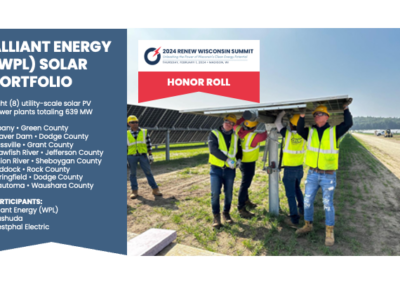
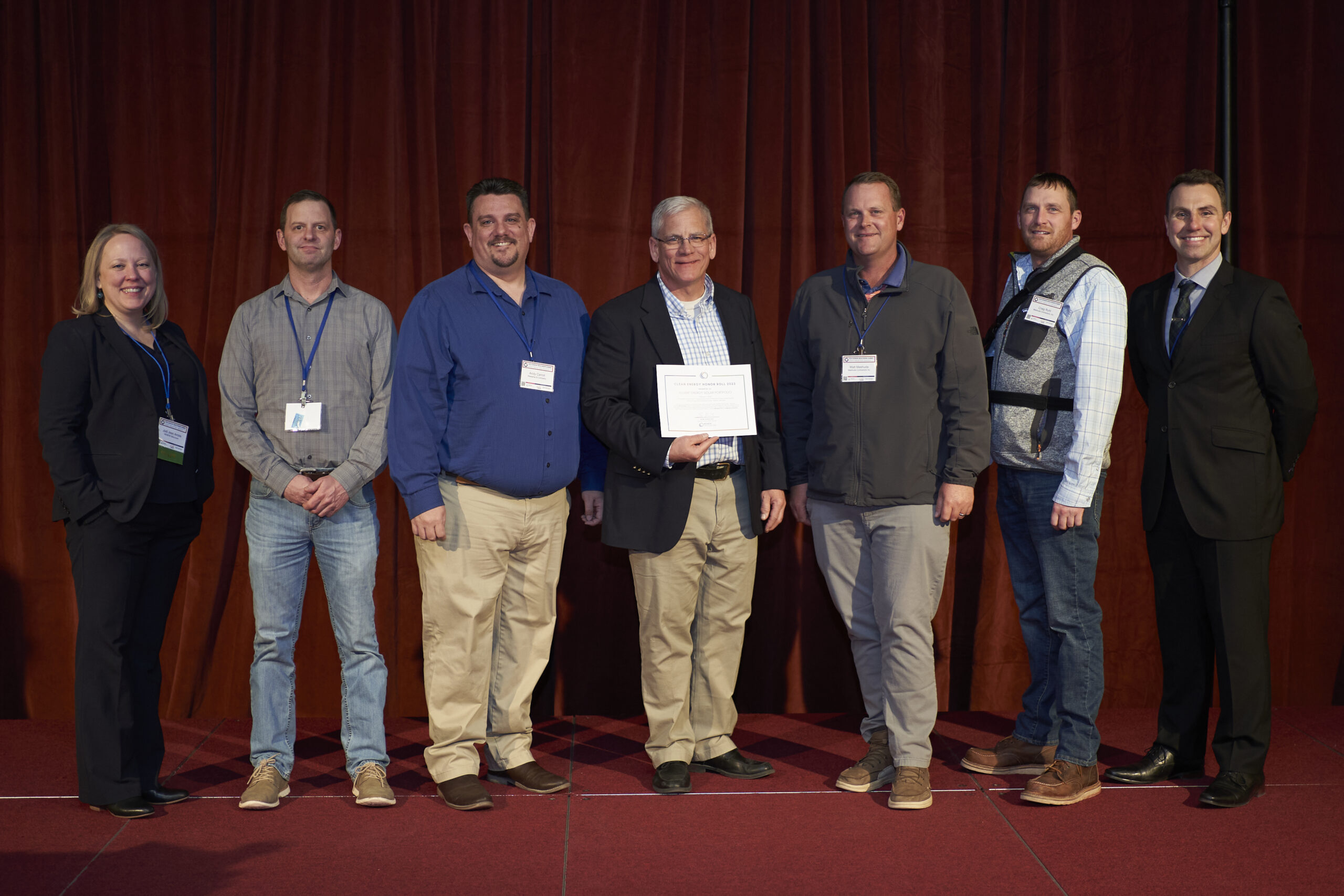
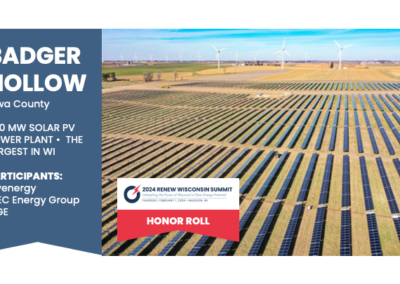
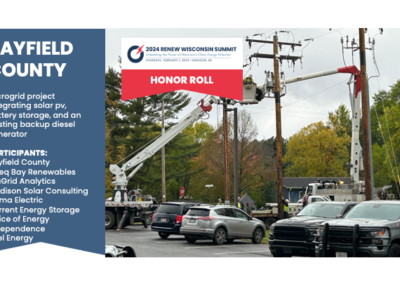
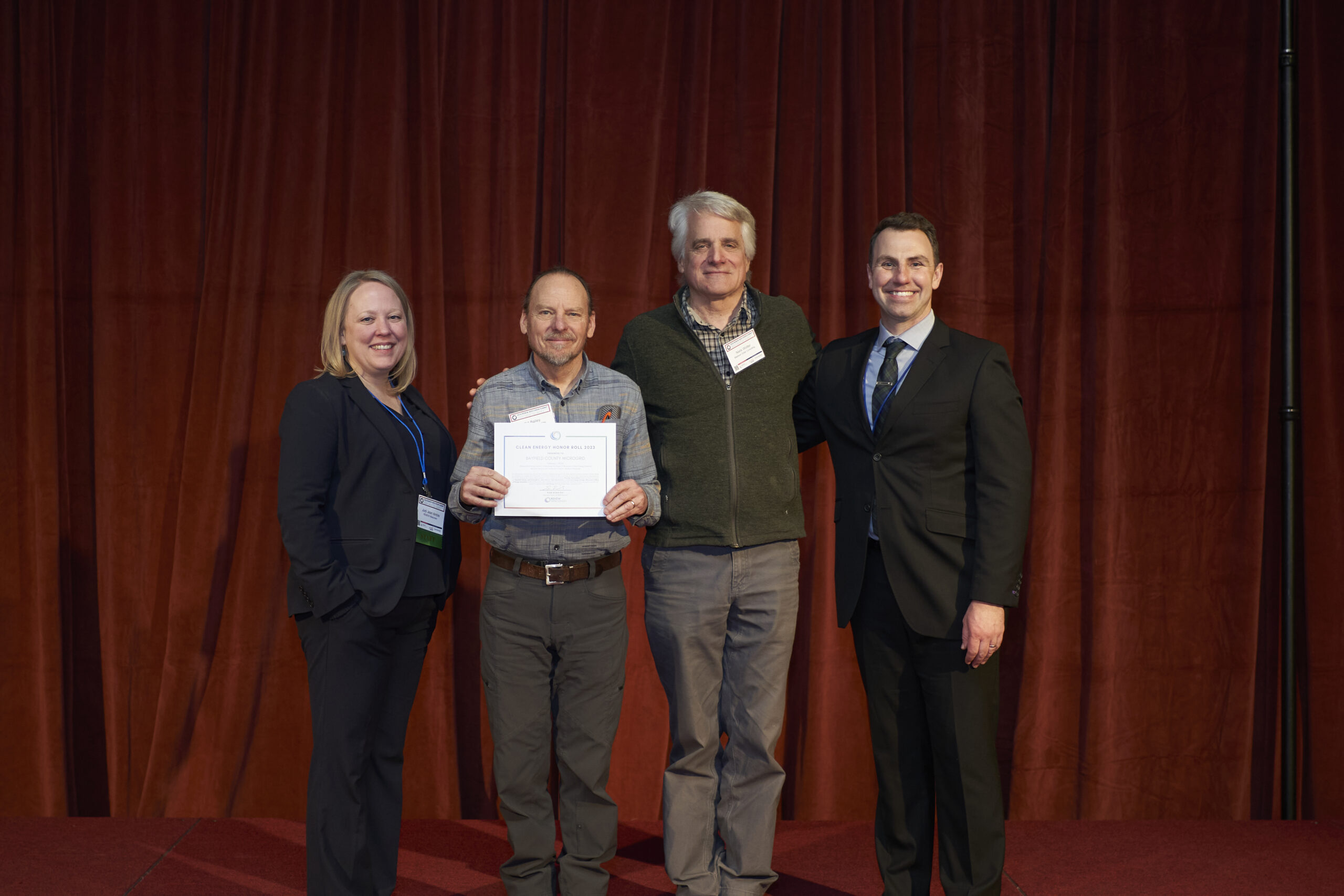
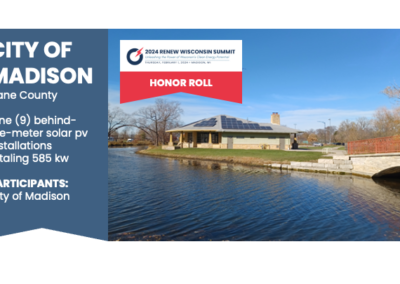
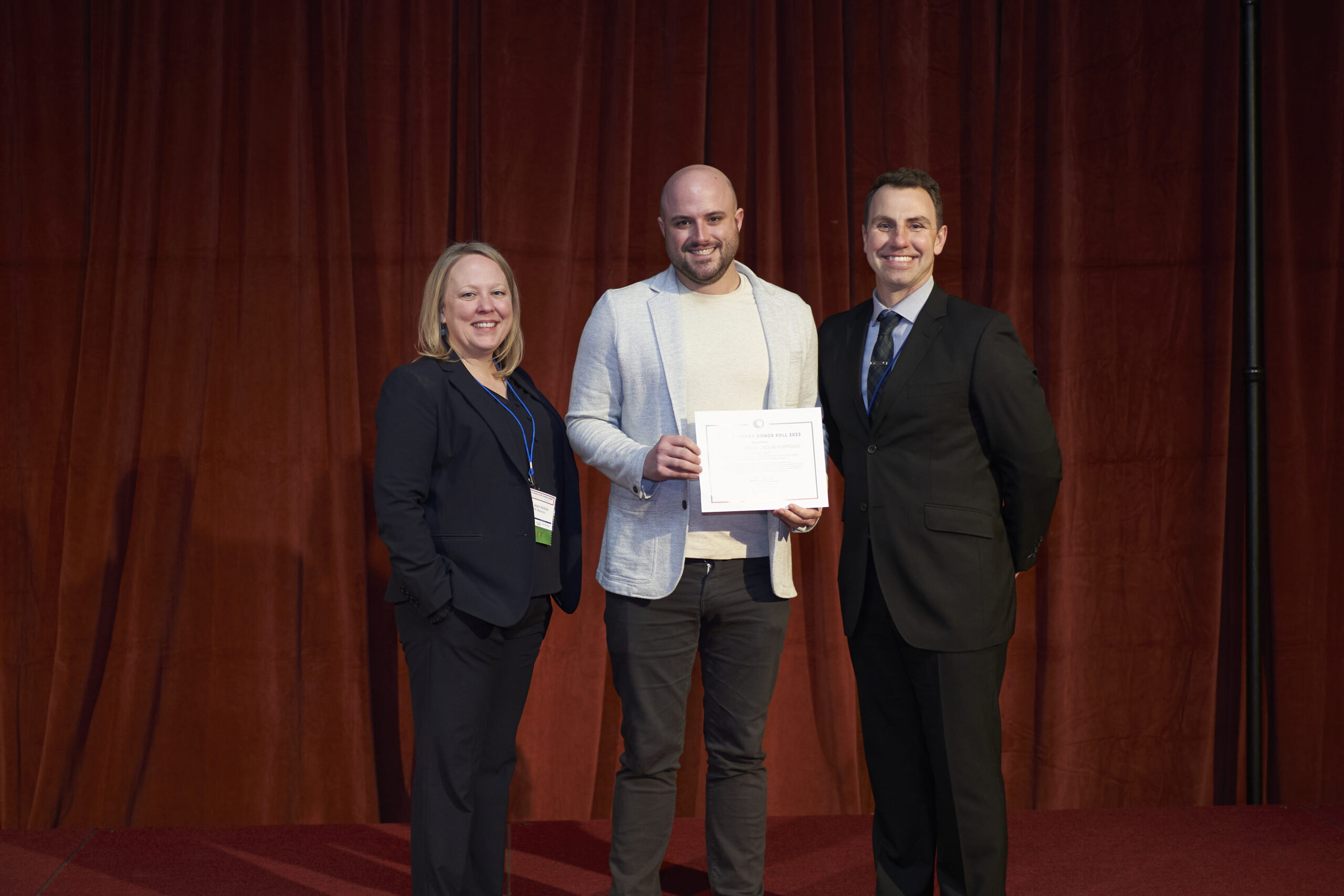
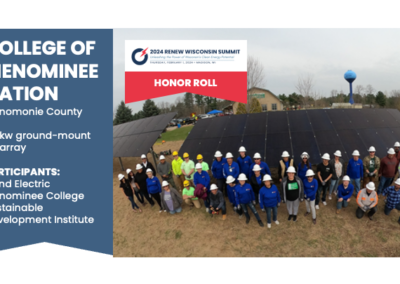
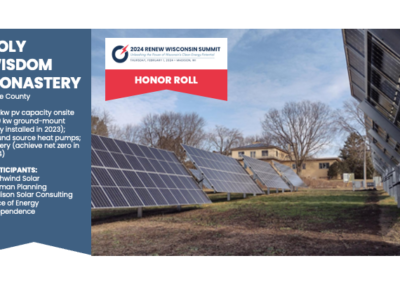
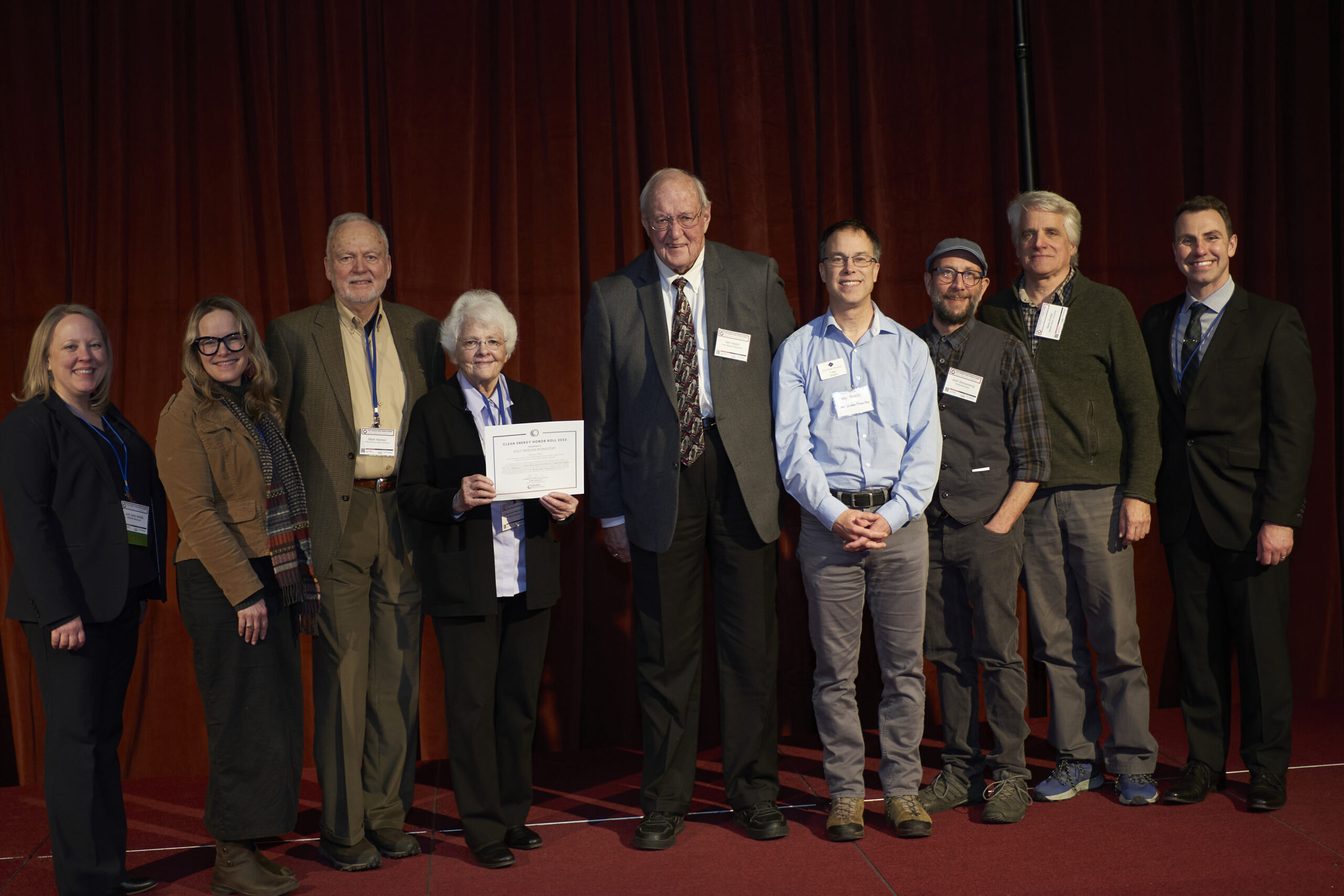
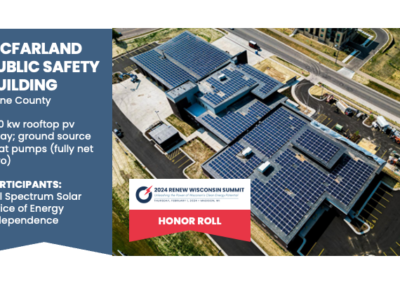
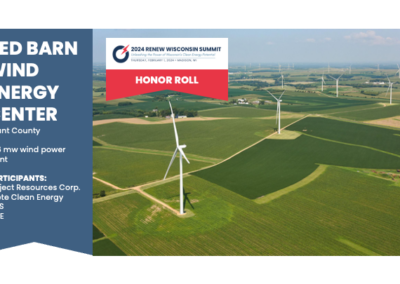
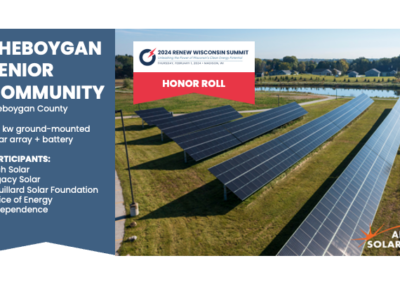
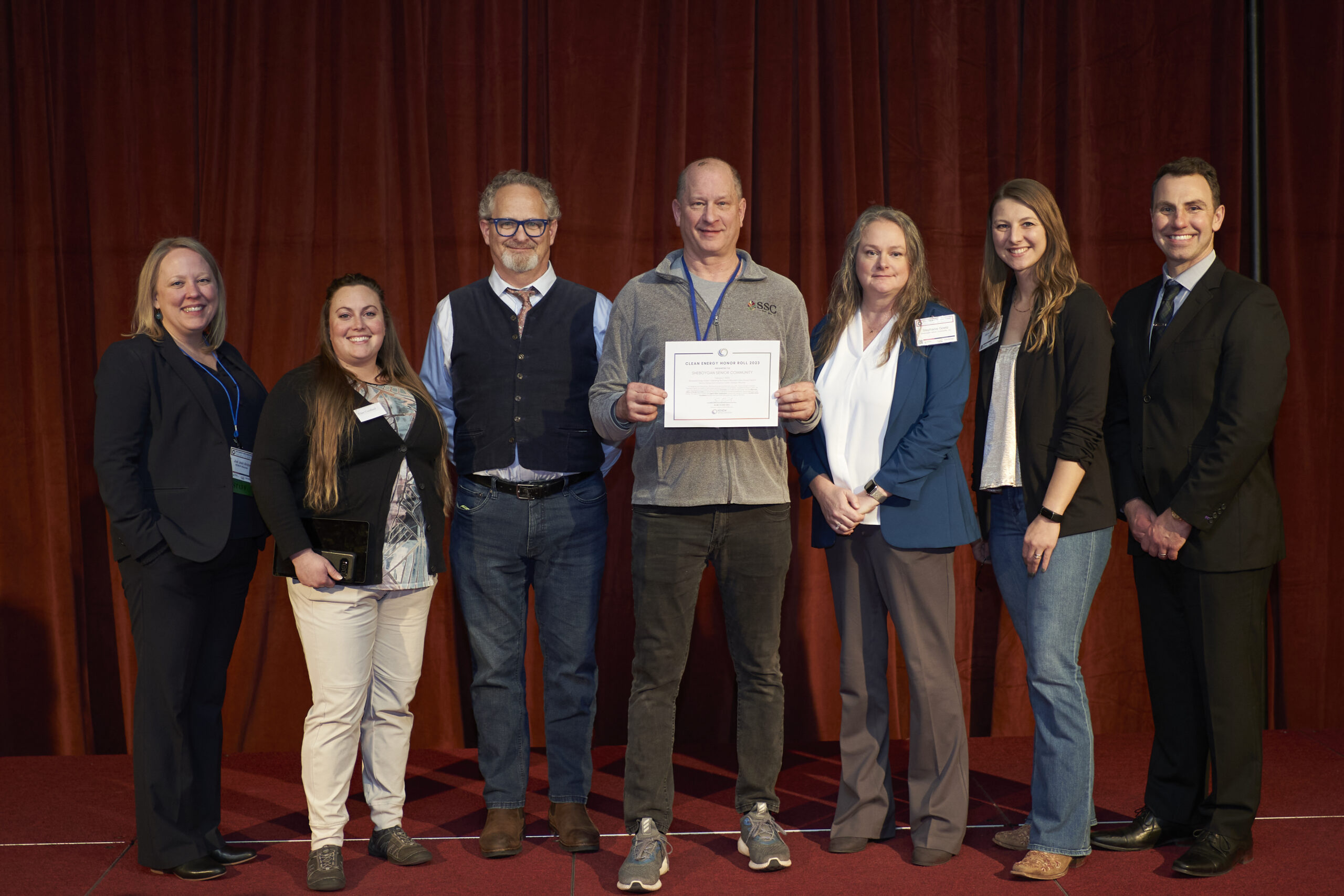

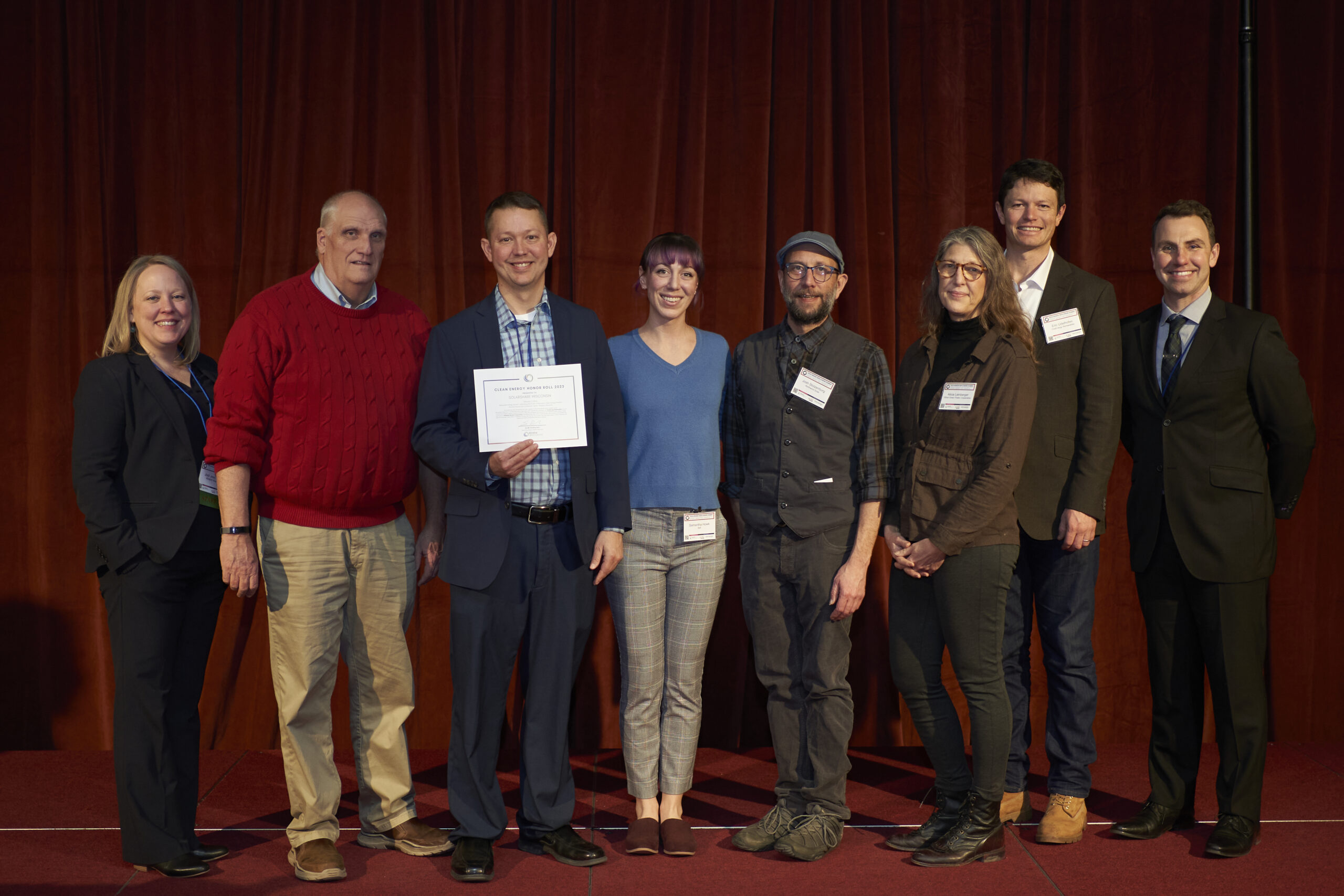

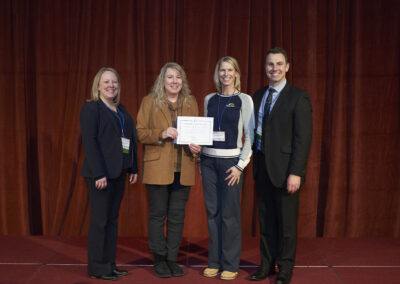
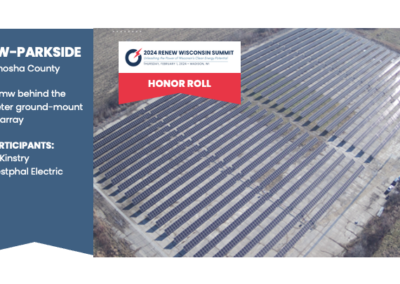
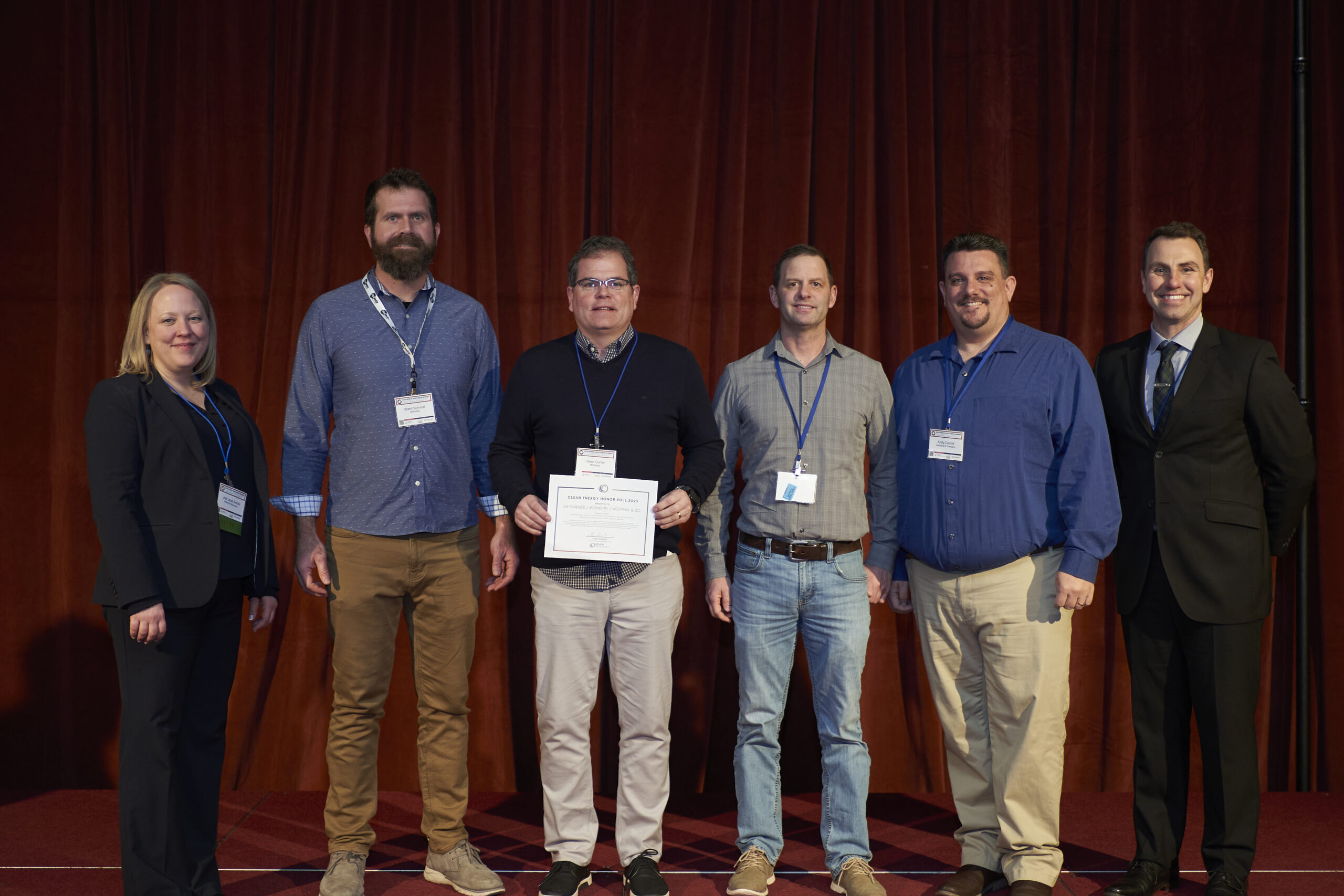
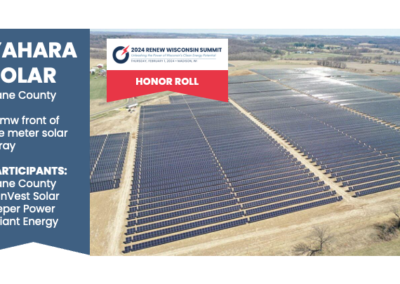
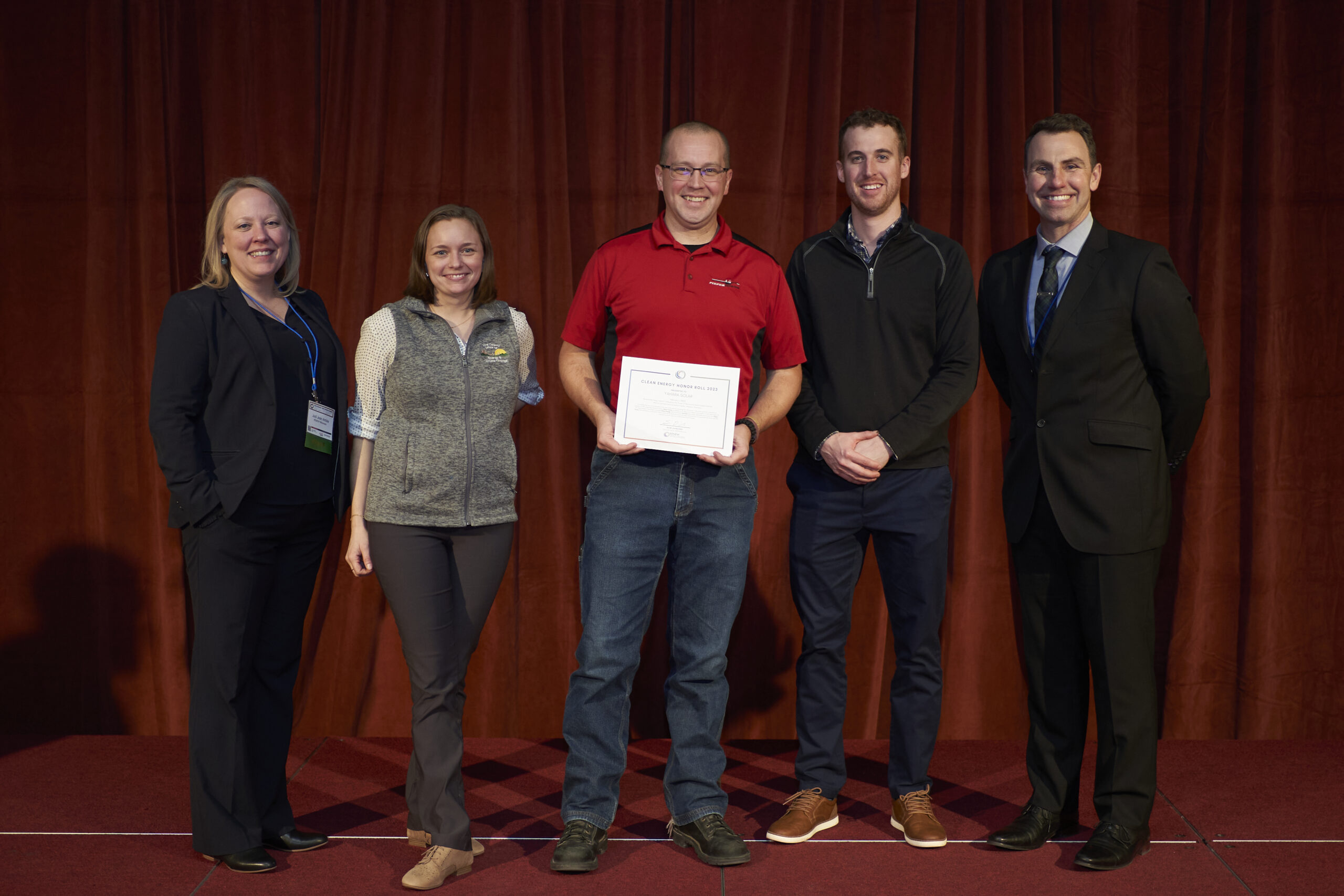




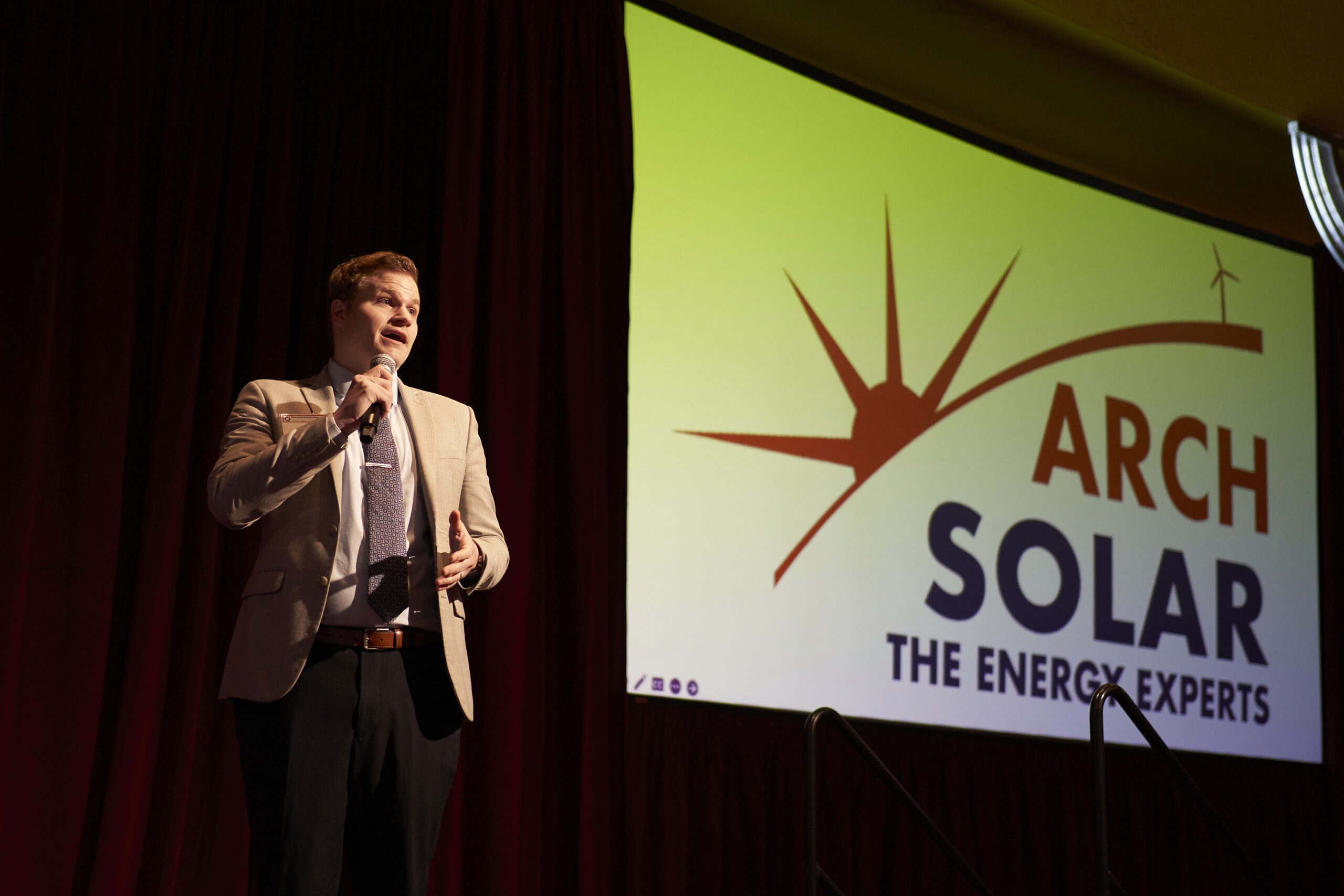
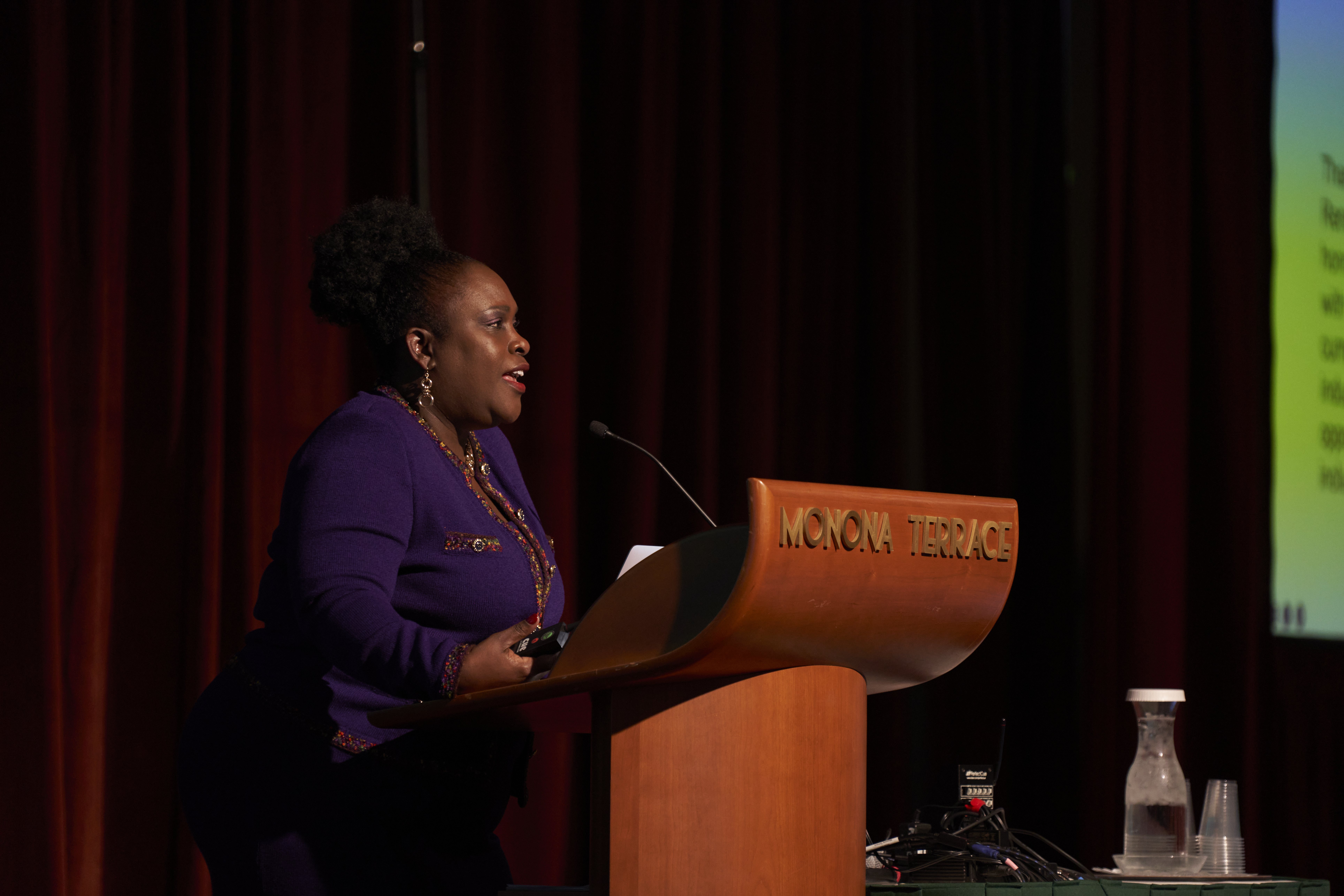
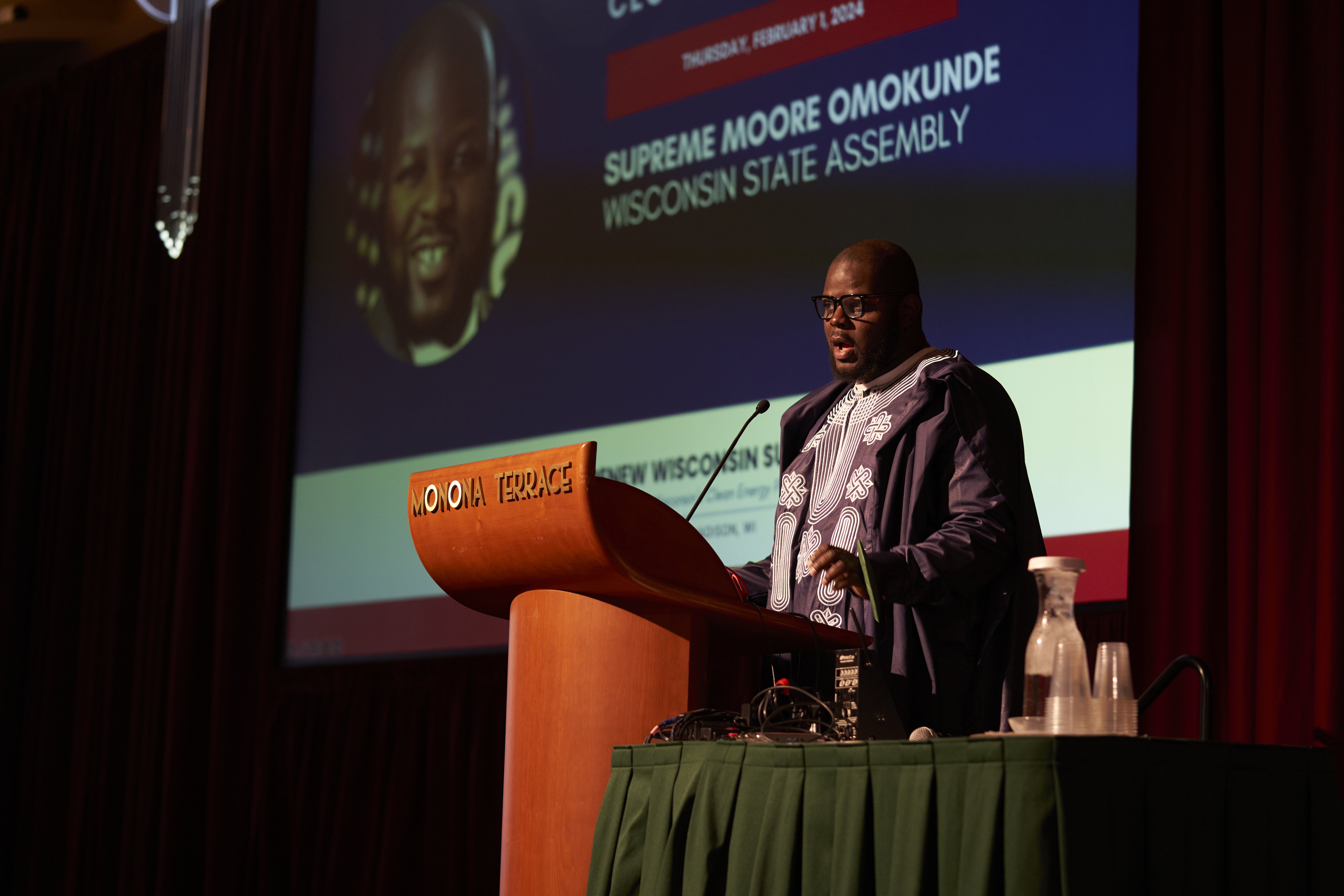
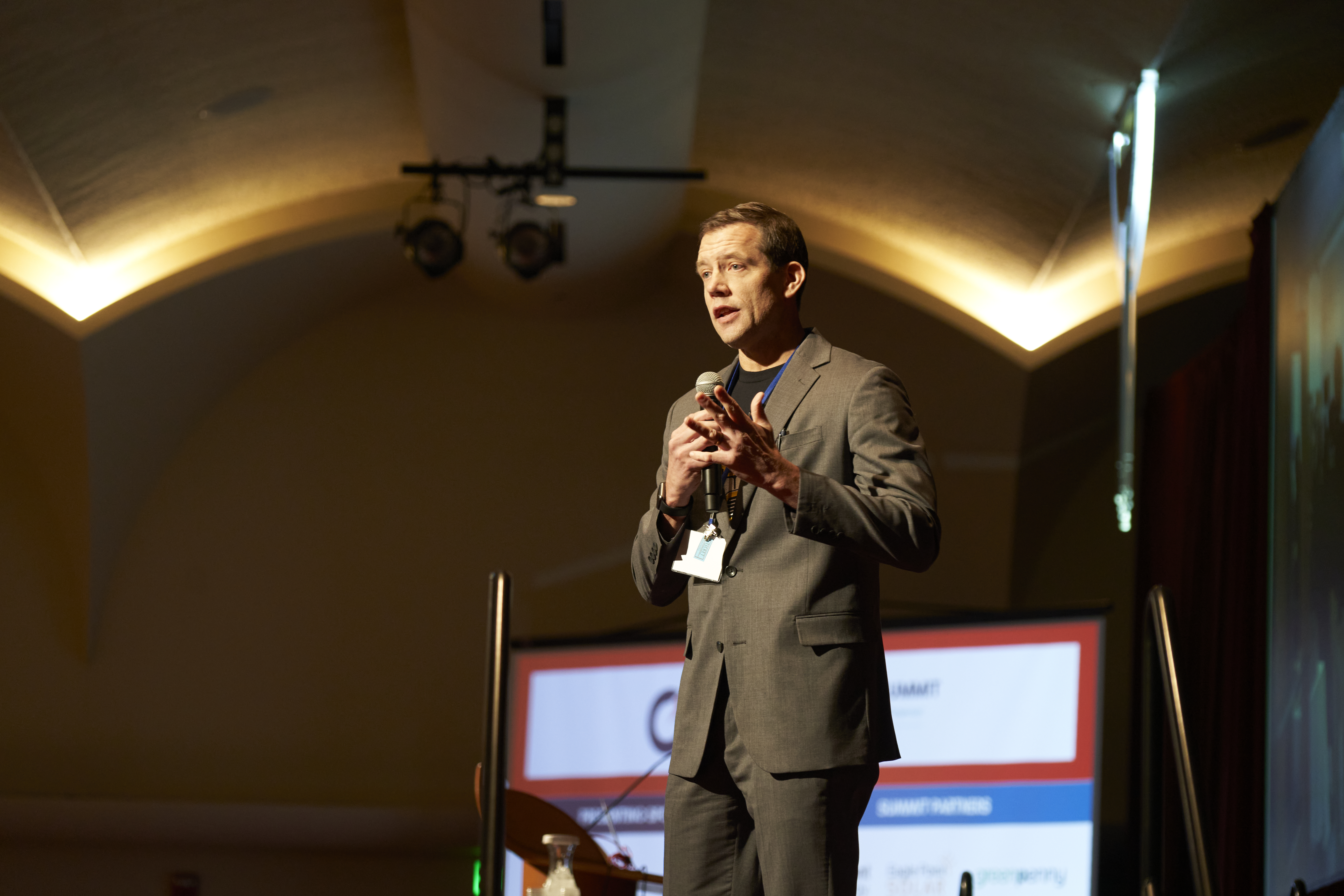
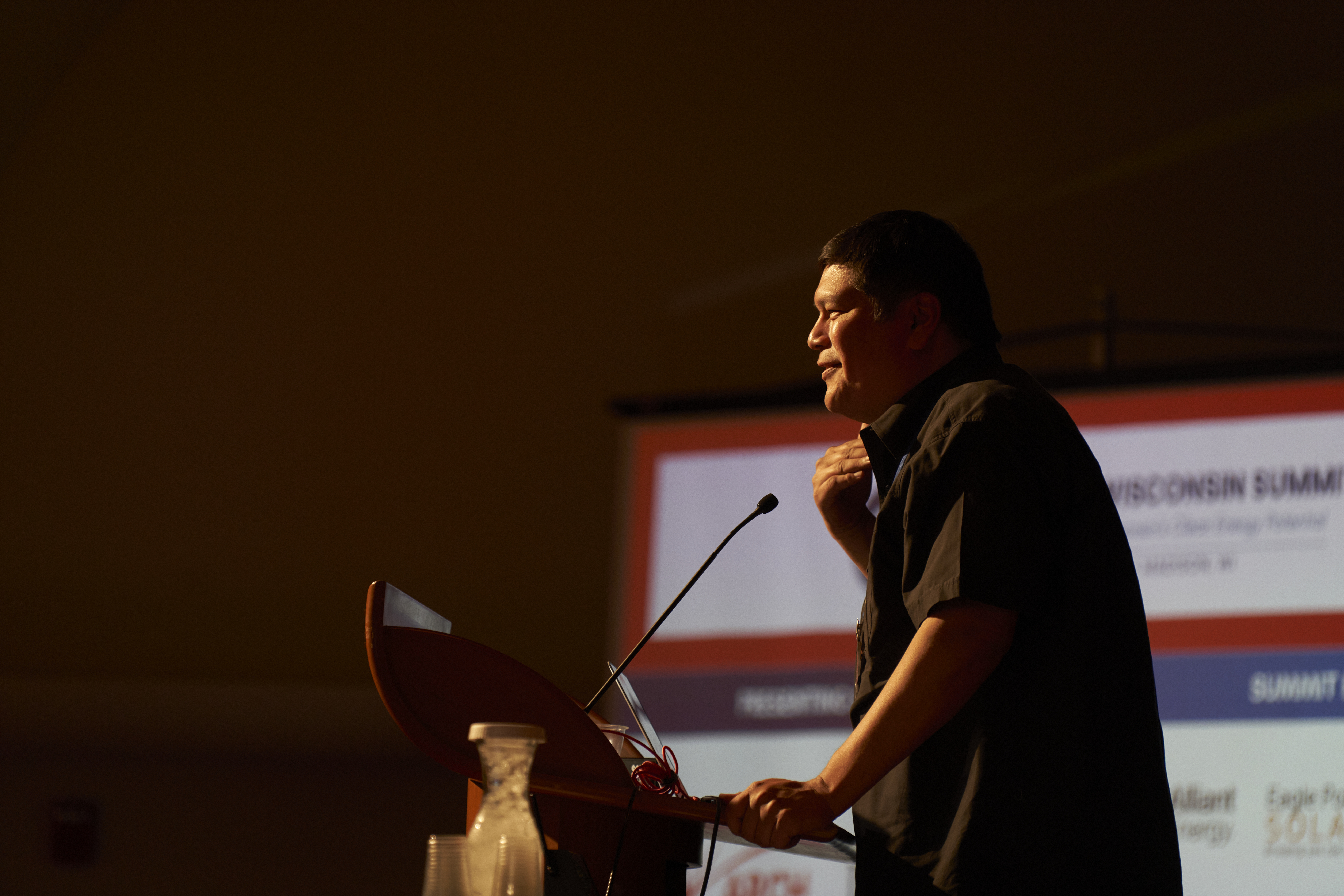
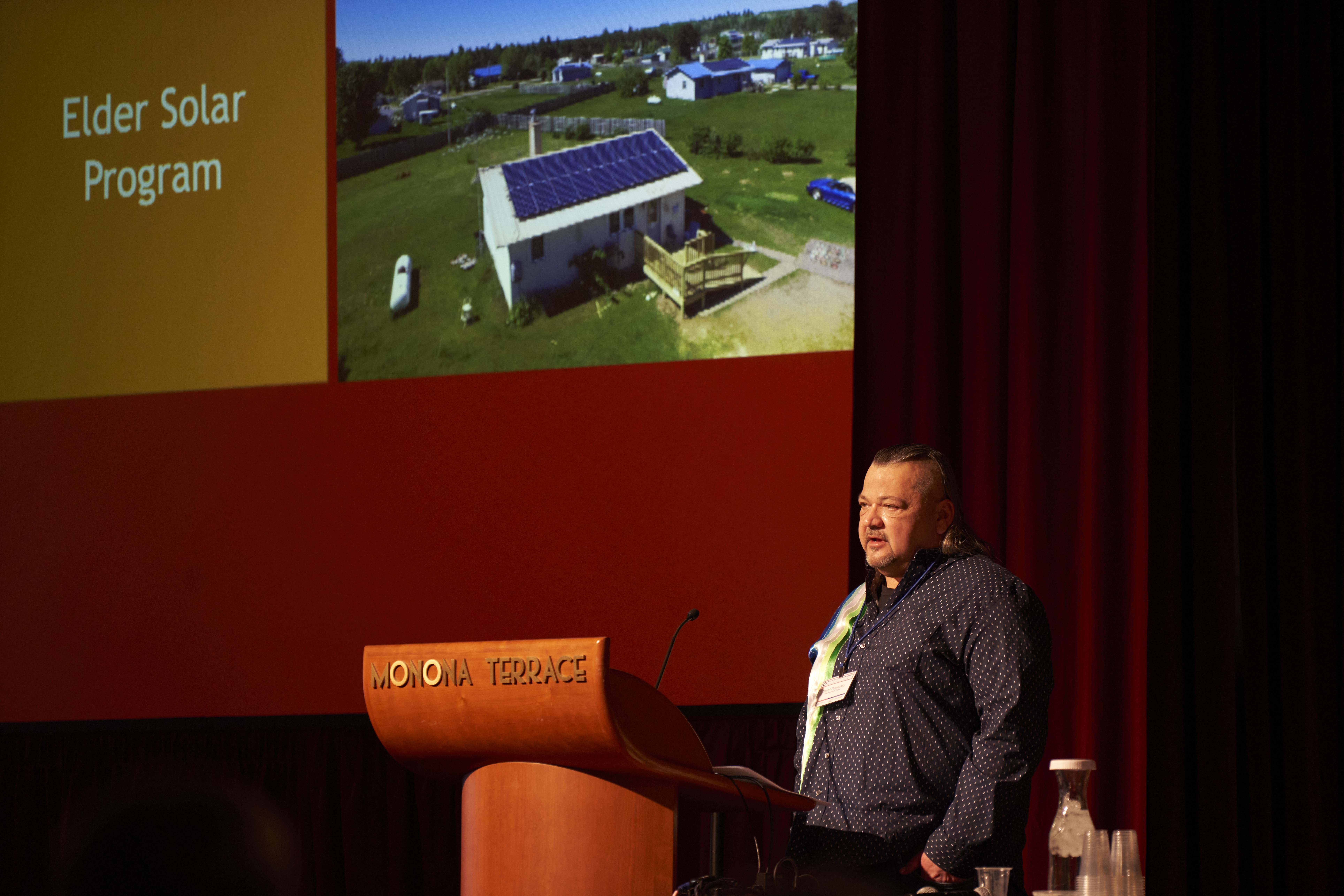

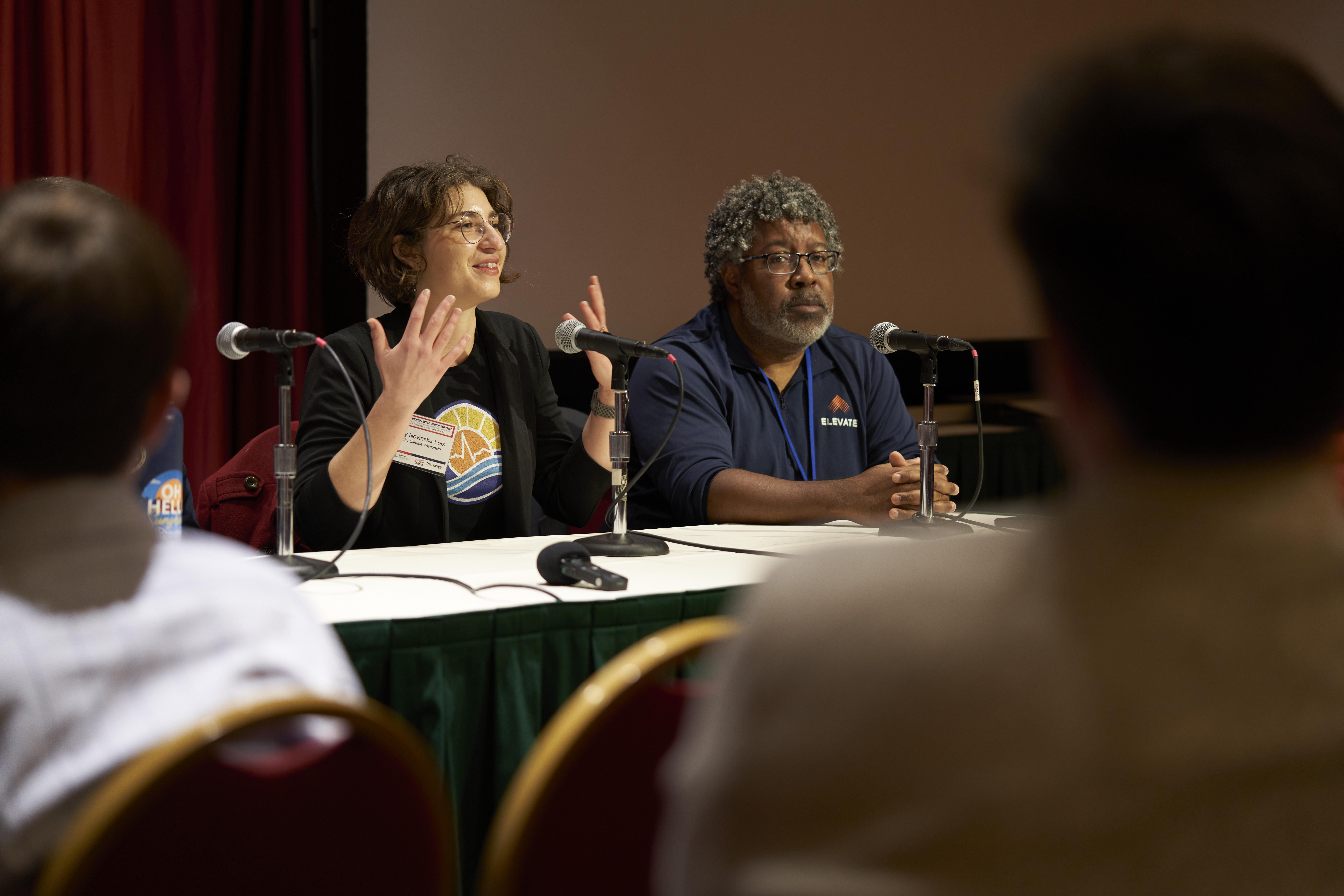
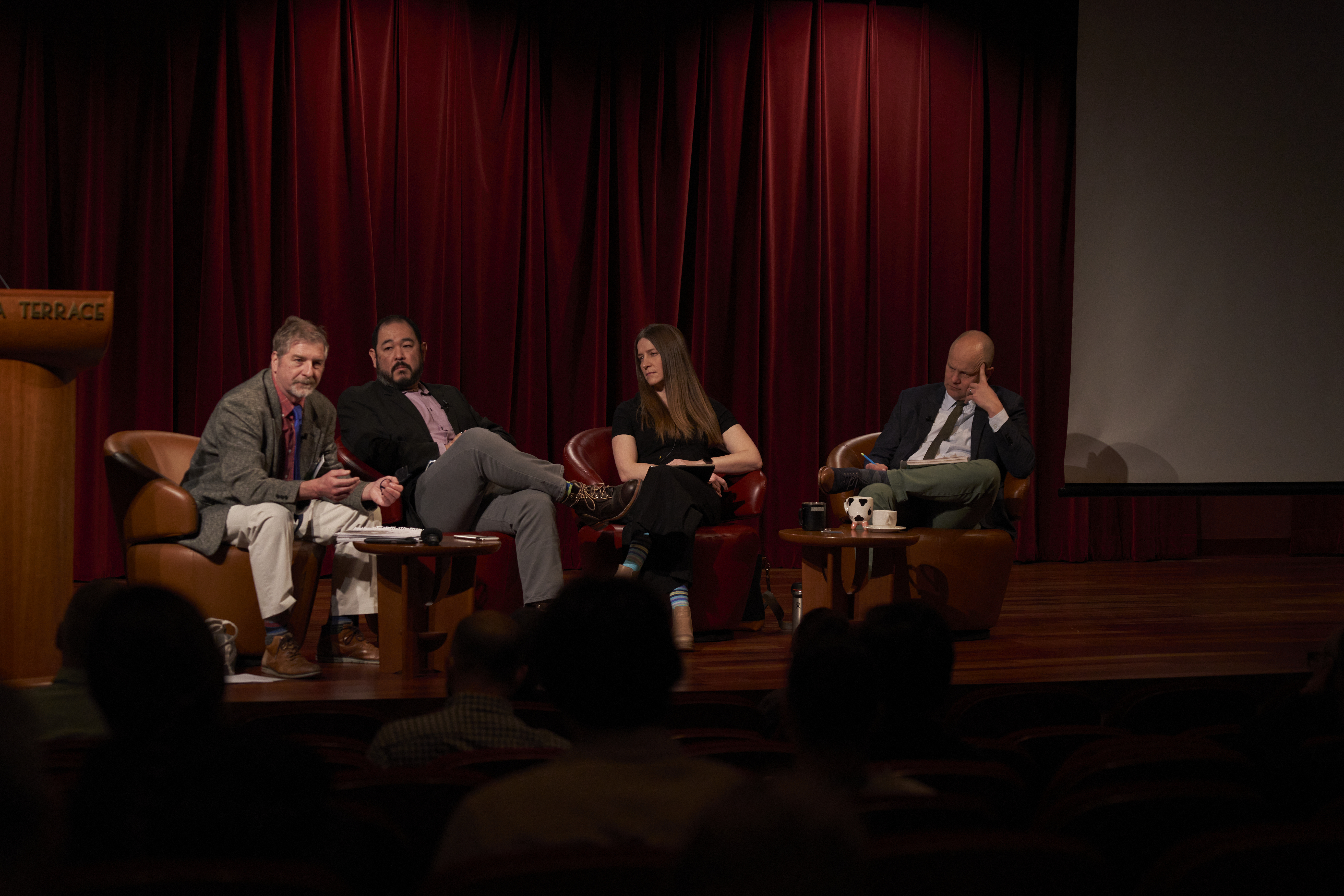
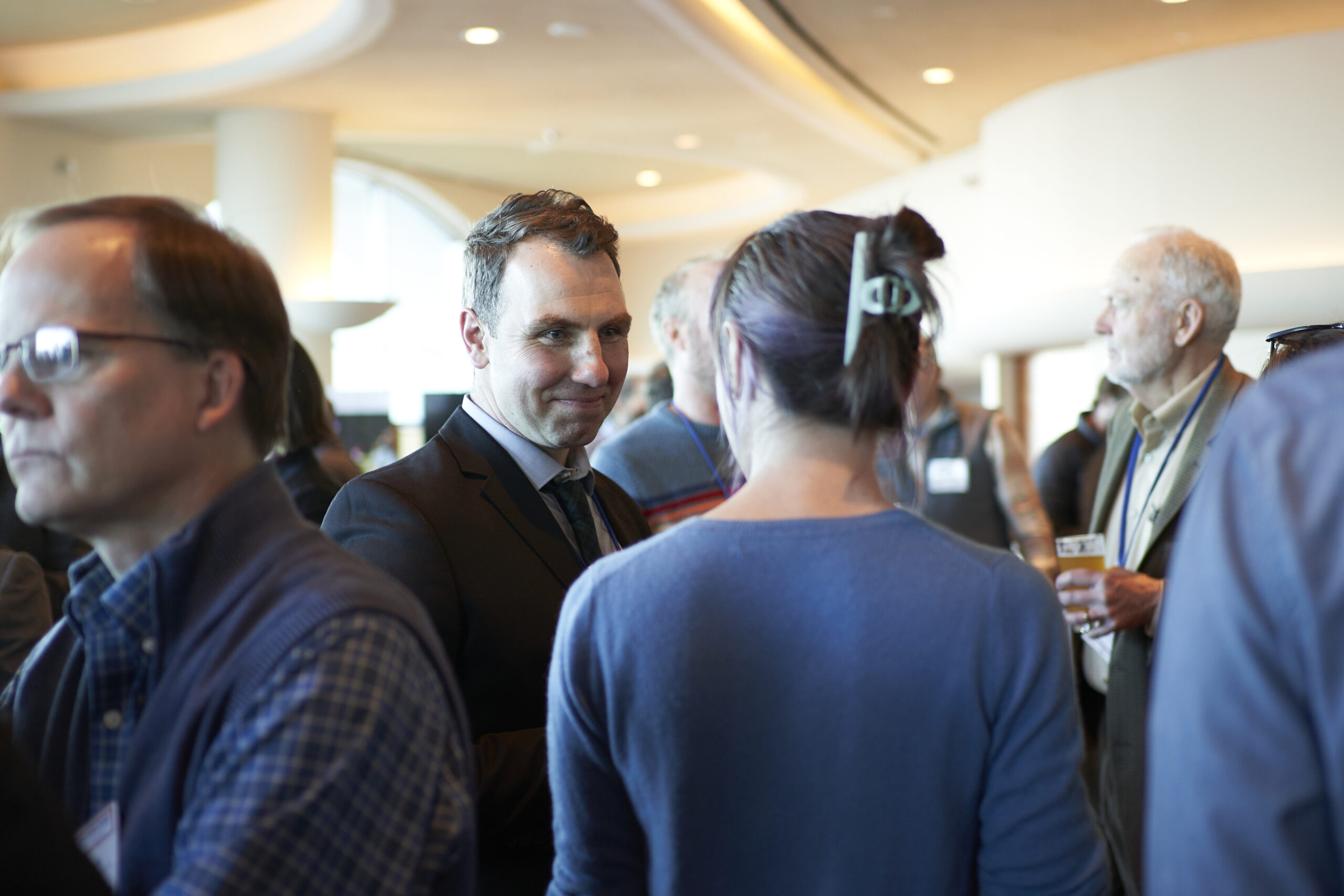
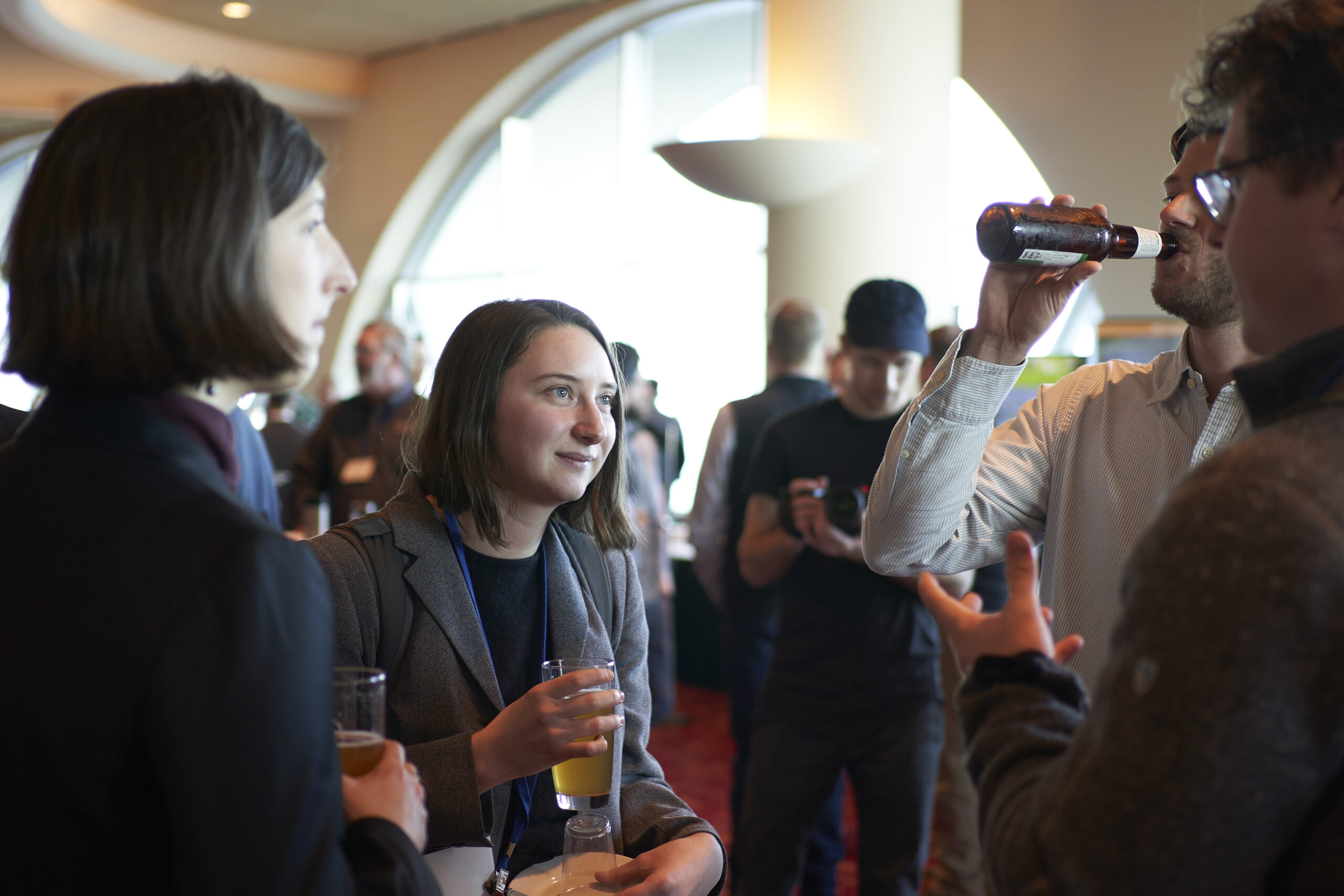
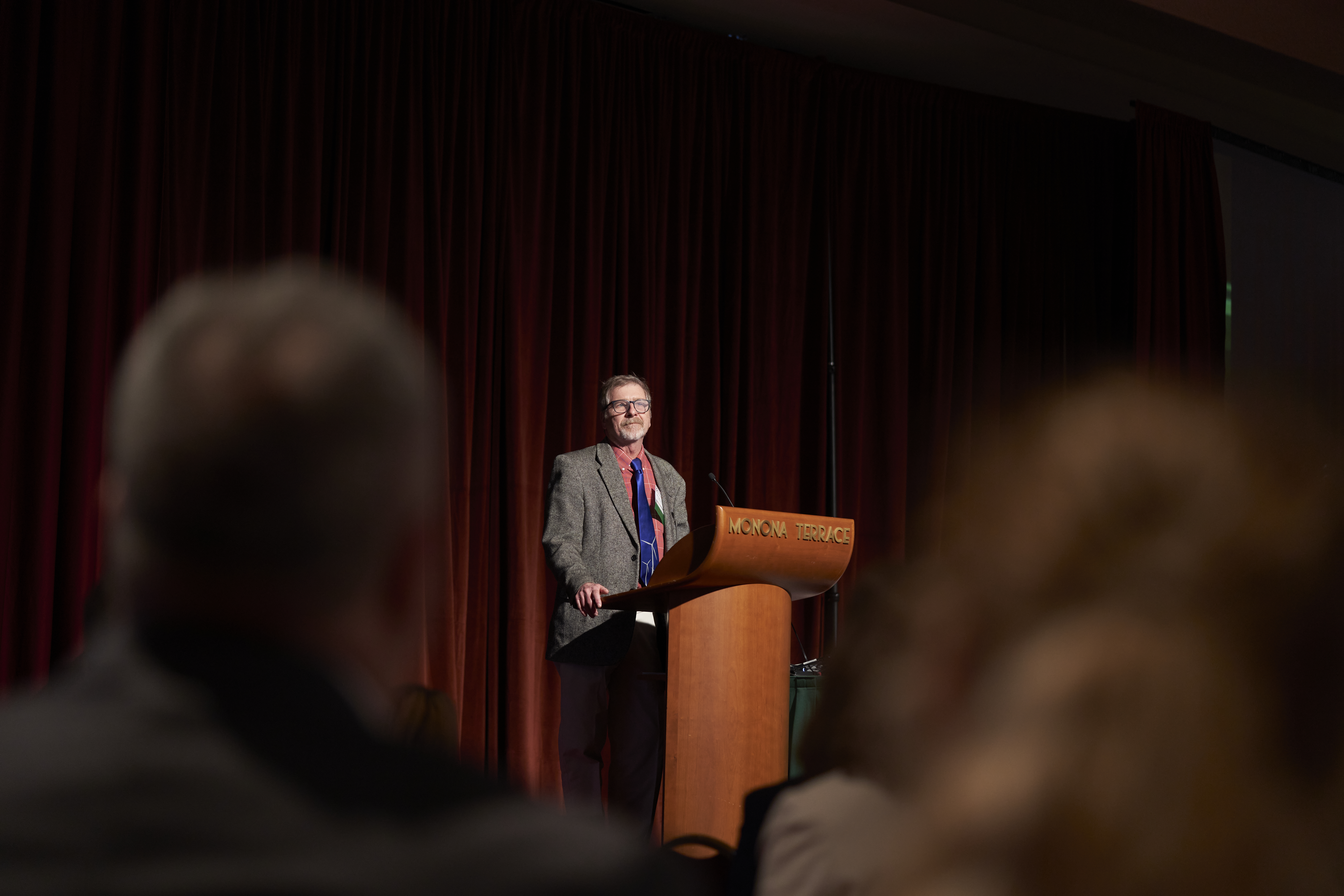
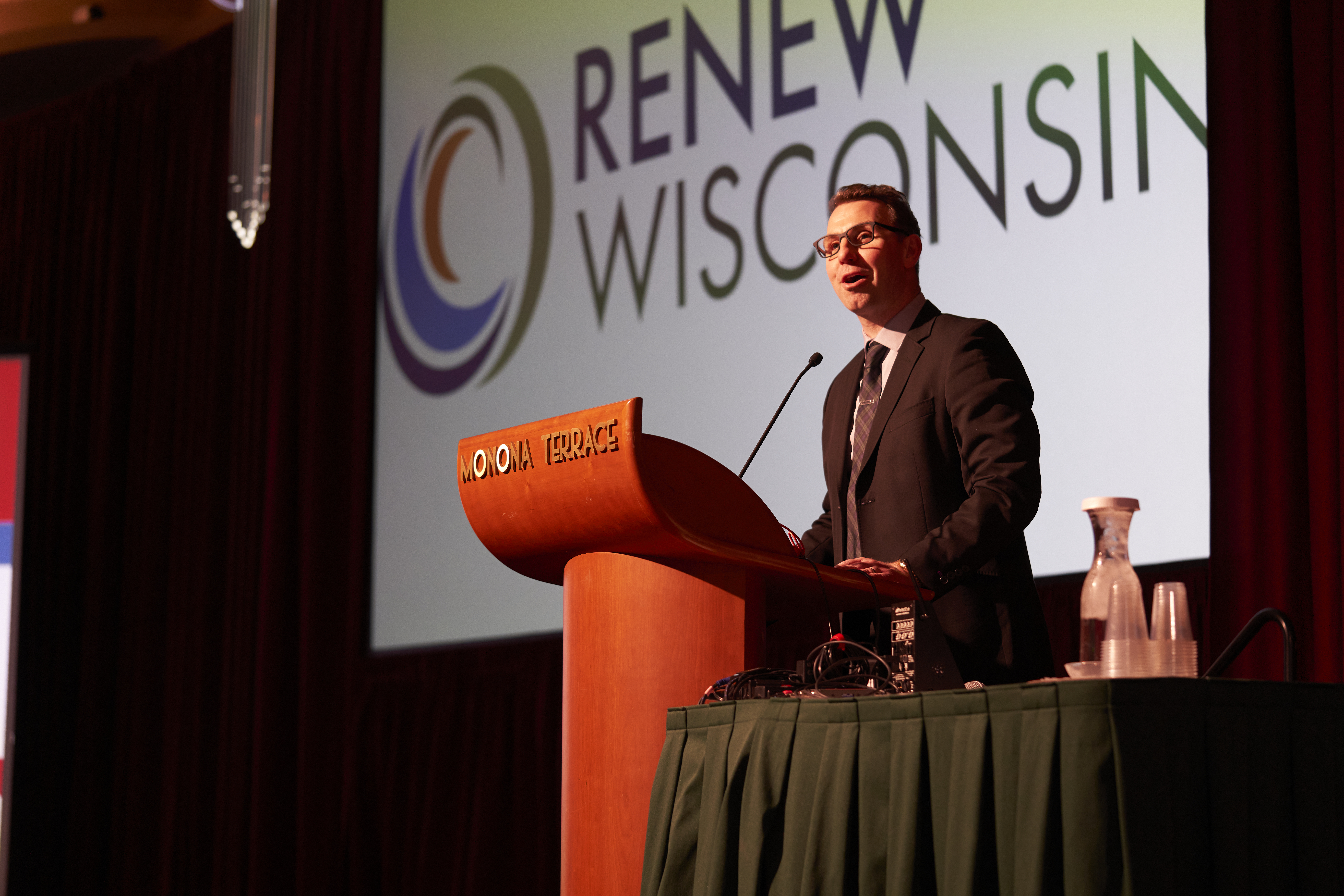
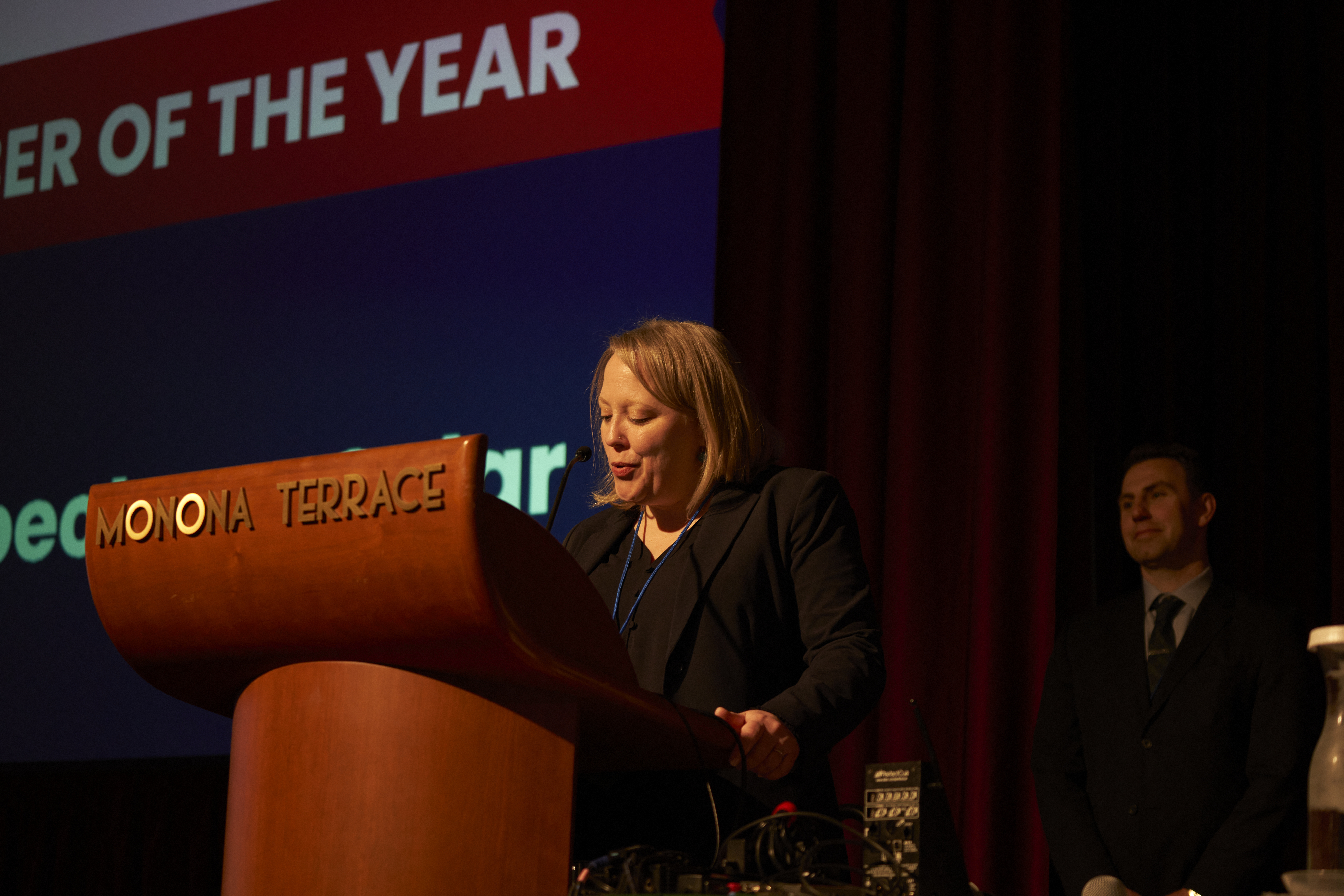
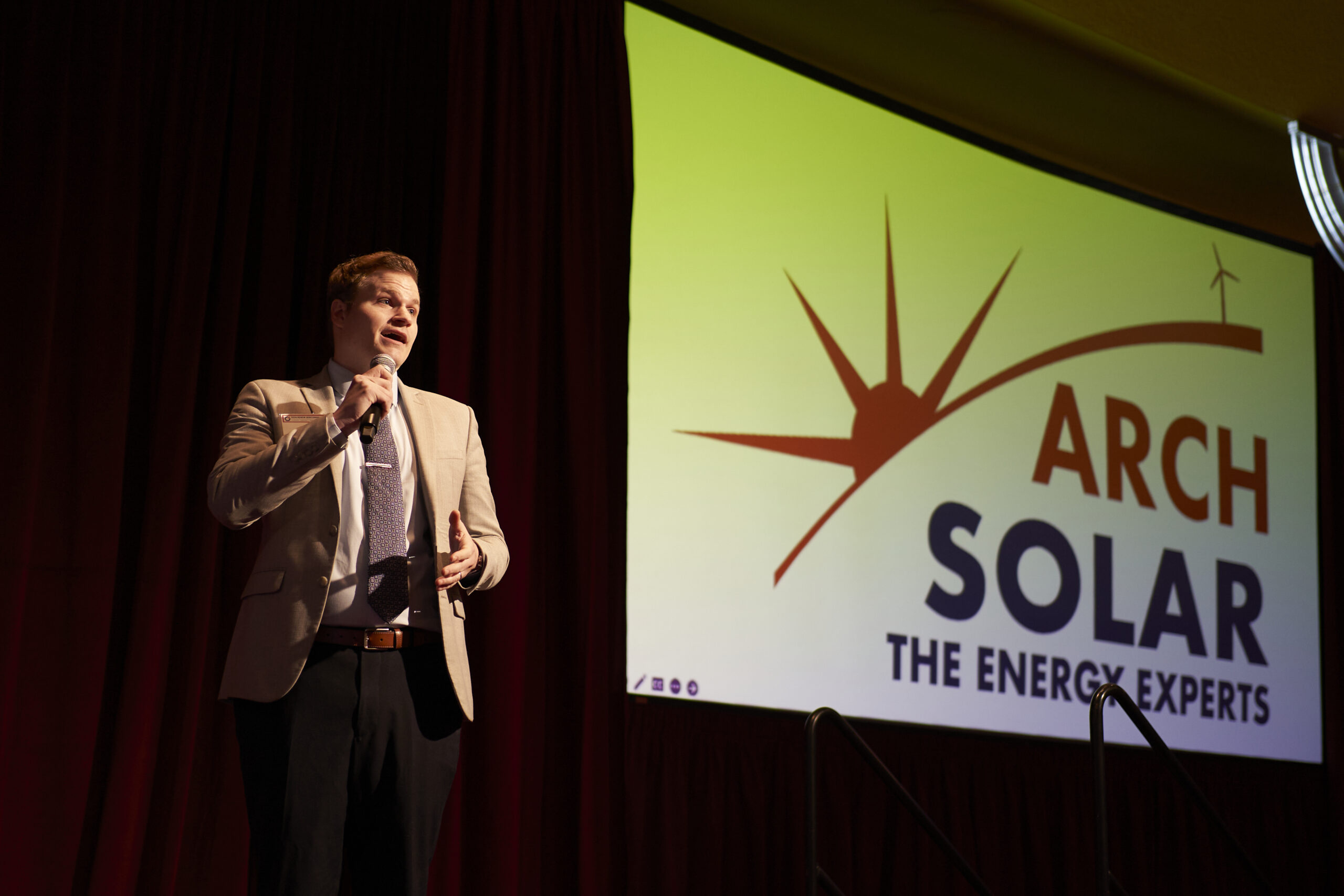
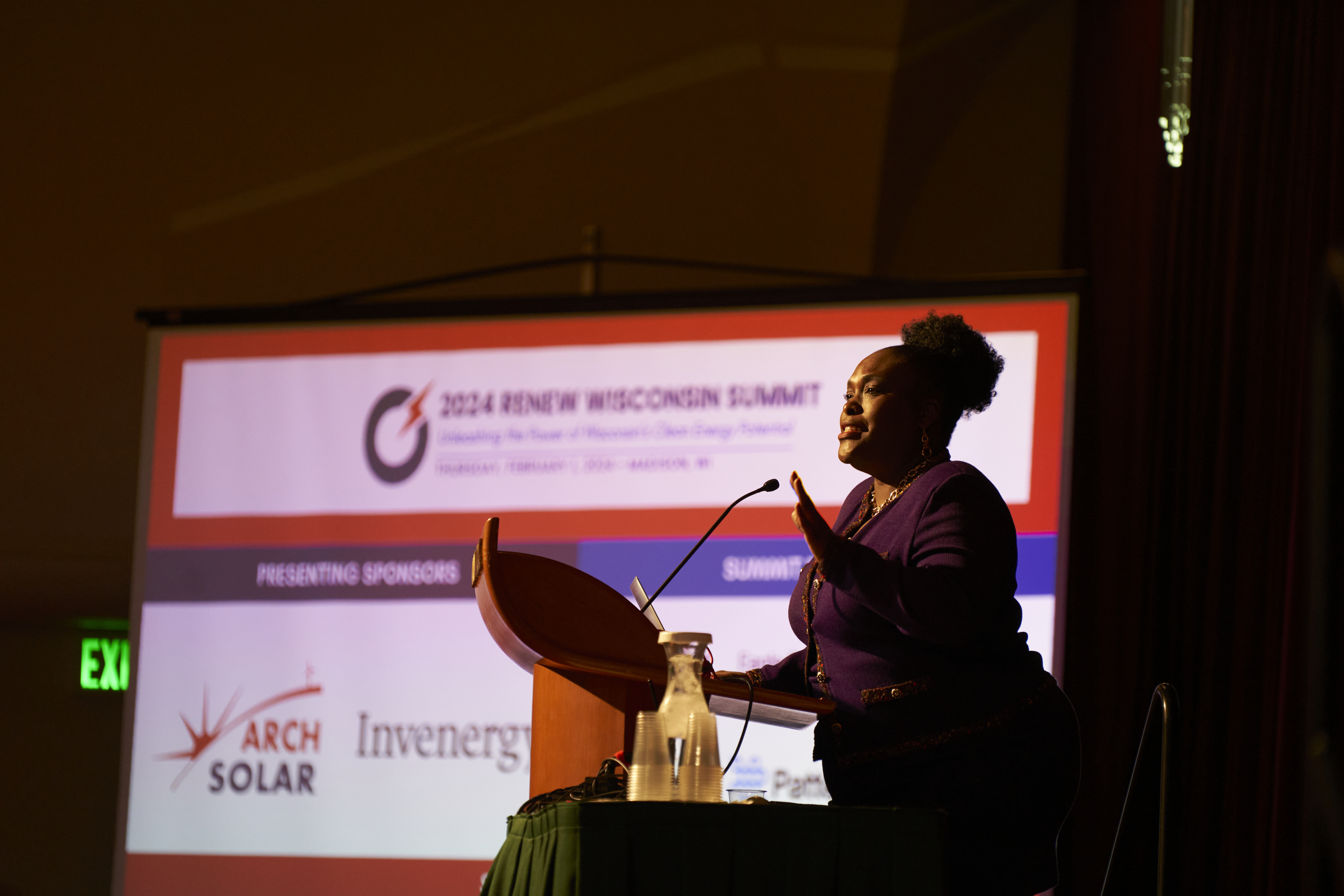

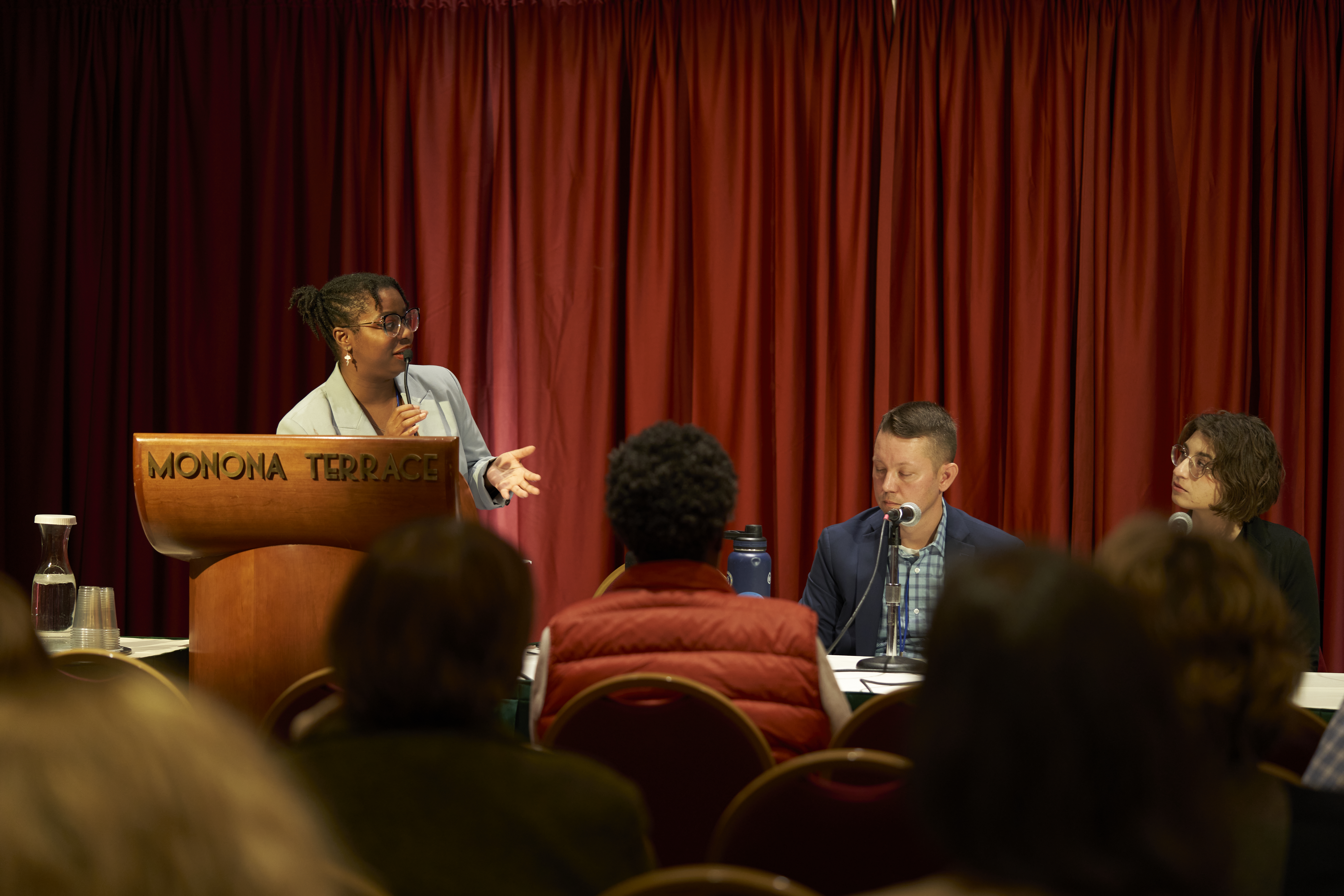
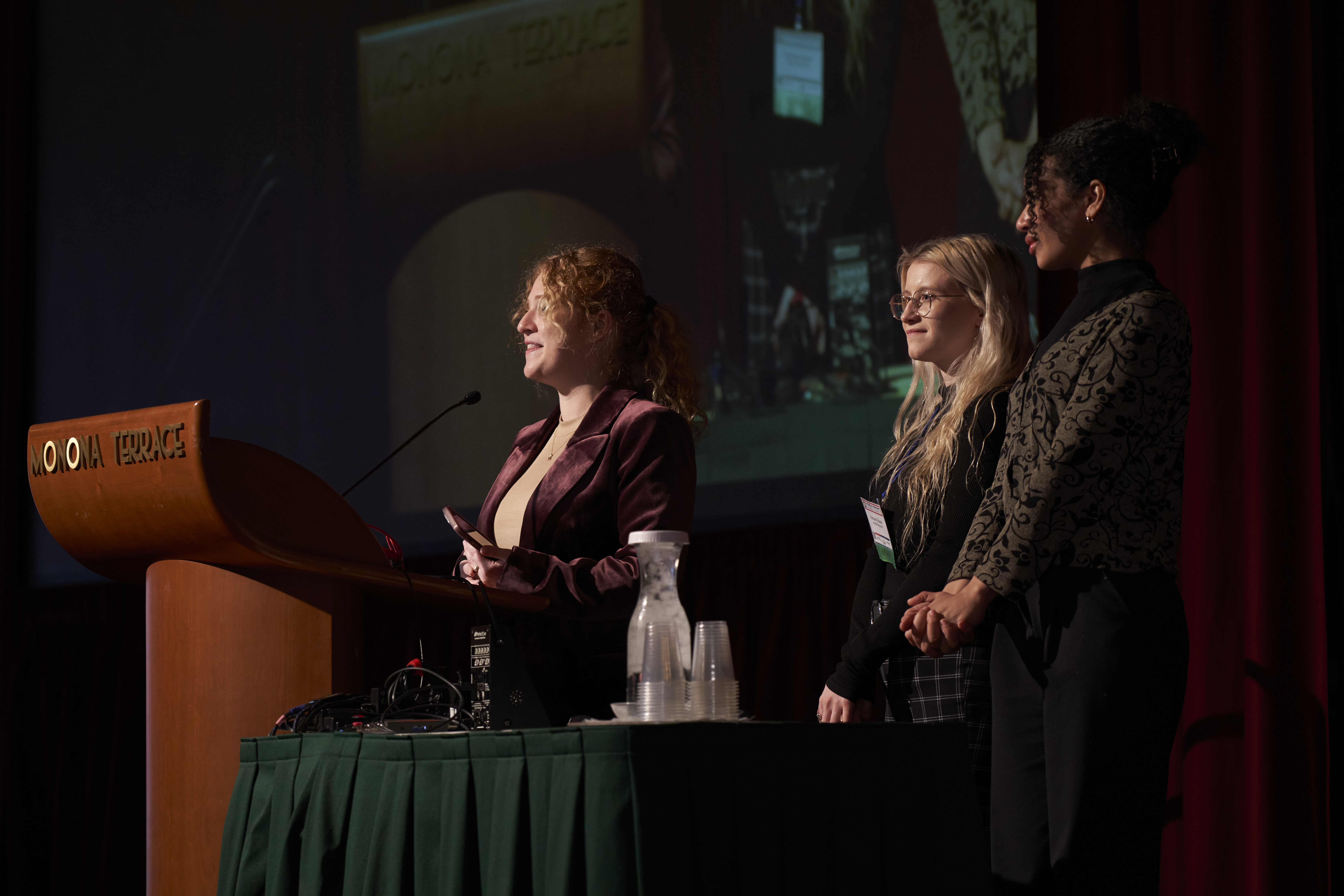
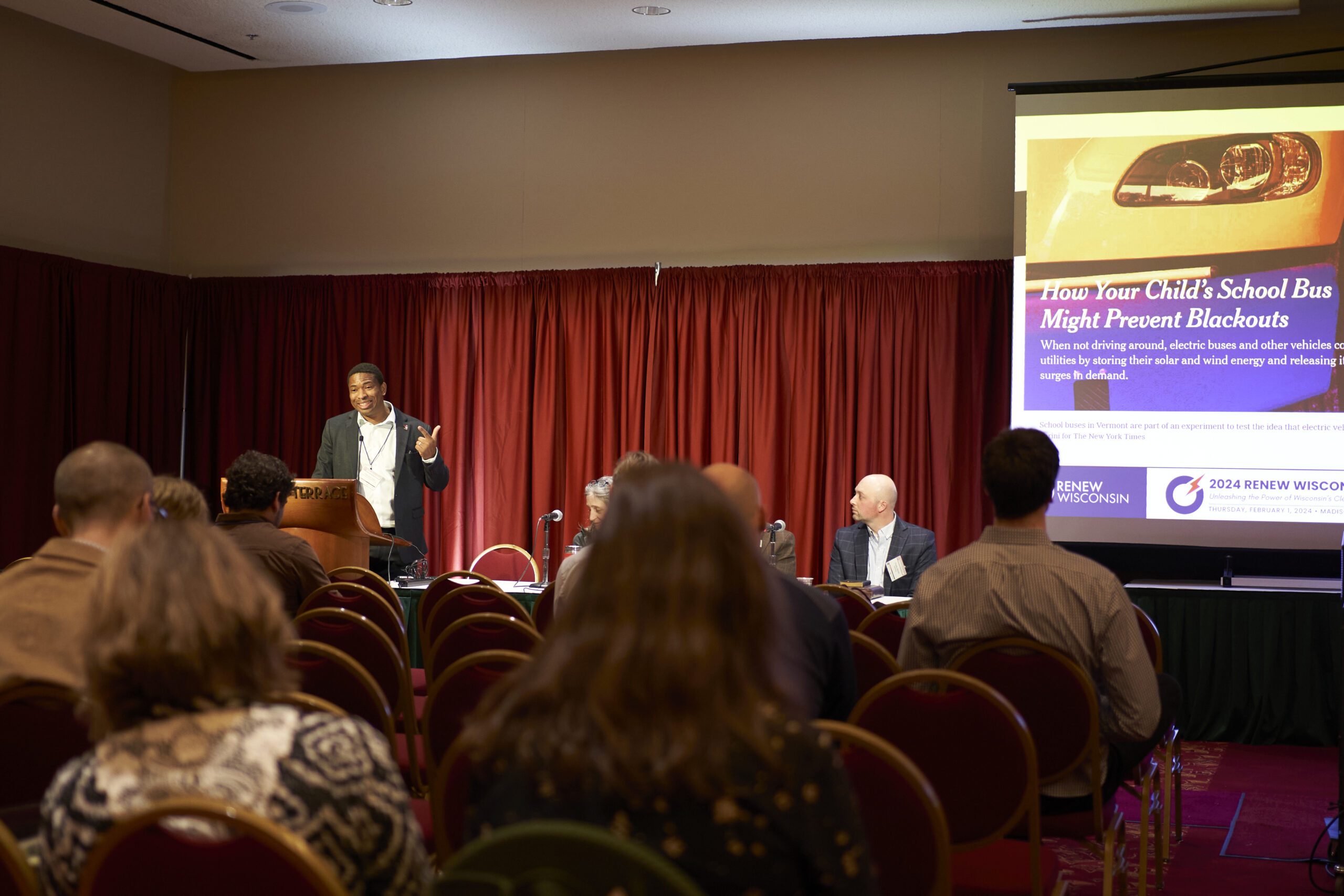
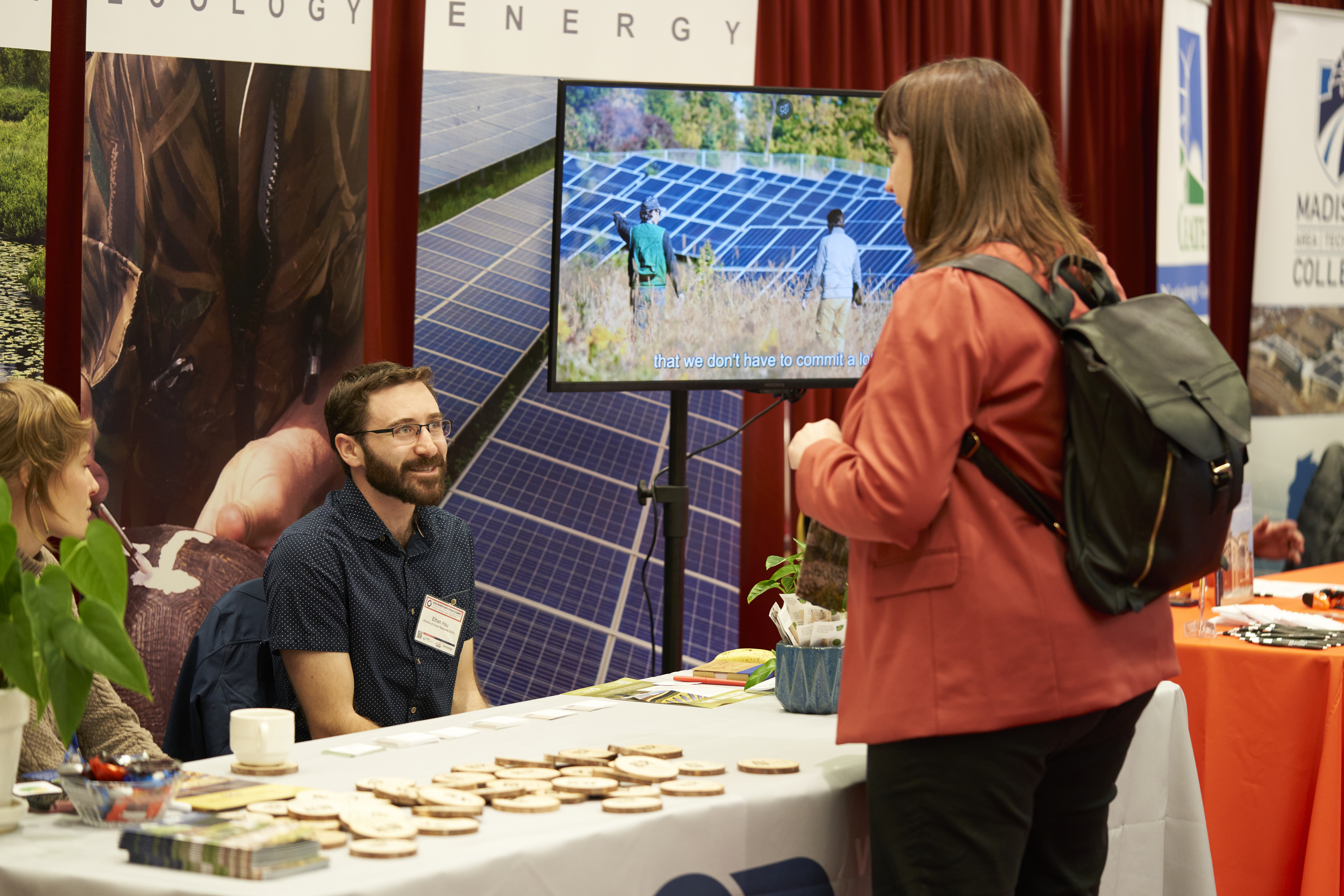
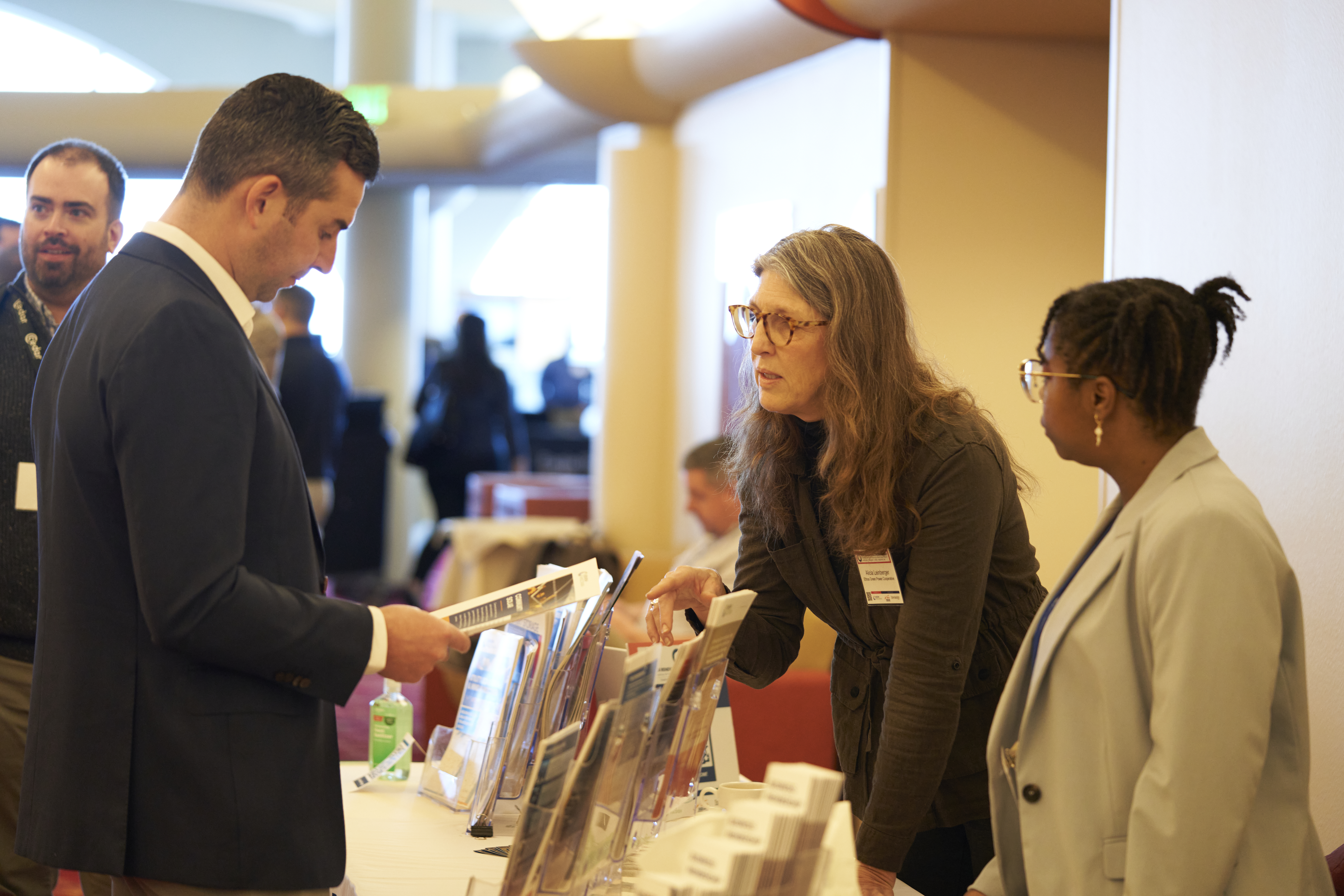


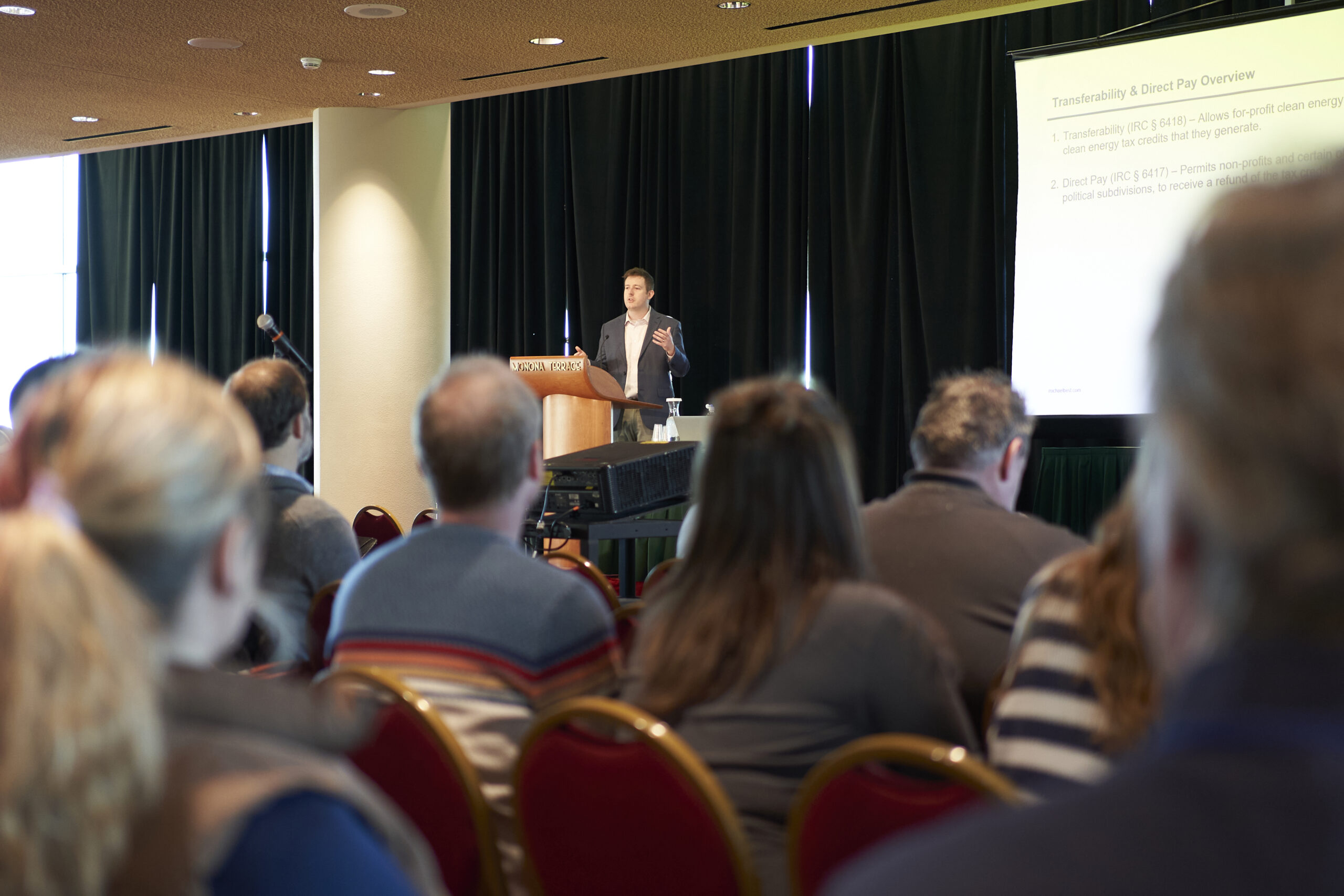

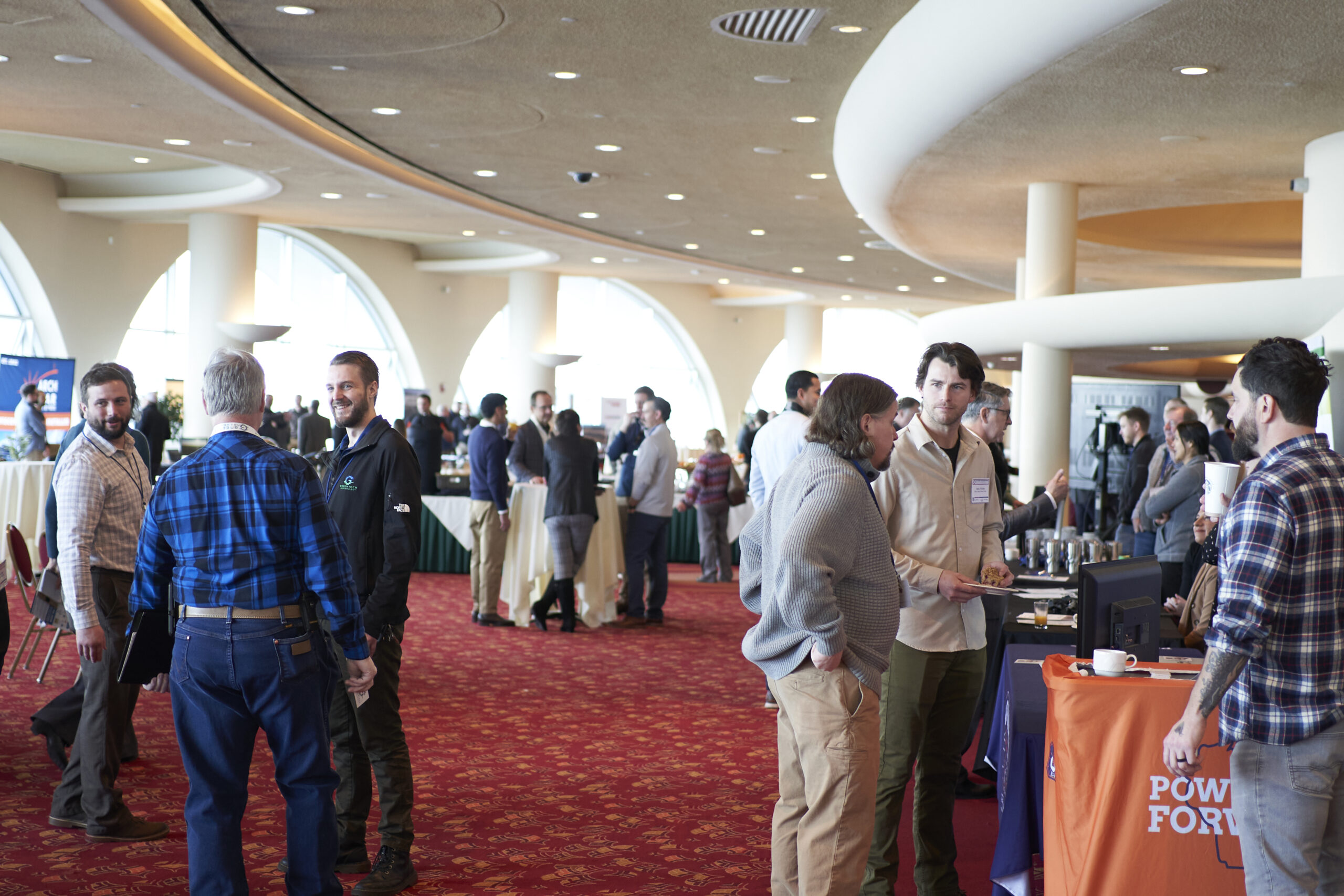



 The Wisconsin State Senate will vote on Public Service Commission of Wisconsin (PSCW) Commissioner Tyler Huebner’s appointment this week. Help us keep Wisconsin moving forward by urging your State Senator to vote to confirm Commissioner Huebner.
The Wisconsin State Senate will vote on Public Service Commission of Wisconsin (PSCW) Commissioner Tyler Huebner’s appointment this week. Help us keep Wisconsin moving forward by urging your State Senator to vote to confirm Commissioner Huebner.



